
























10 A season of Hope and Opportunity RID Bharat Pandya shares his thoughts on the Covid-19 crisis.
20 A grief-stricken Rotarian couple gives Jeevandaan to four people
A moving account of how Rtn Bikkina Chakravarthi and Bhanu donated the organs of their brain-dead son Srikanth.
22 English language theatre cannot represent the vastness of Indian theatre: Vijay Padaki
An interview with the founding trustee of Bangalore Little Theatre who is also a Rotarian.
30 Virtual meetings, the new normal… Rotary e-clubs show the way
Eighty e-clubs from 28 countries participate in a global e-clubs meet addressed by RI President Holger Knaack and Susanne.
32 When pictures speak RID 3040 Interactors organise a photo contest which gets global participation.
44 Afghanistan: more questions than answers An account from the war-ravaged country after a visit in 2005.
58 RC Bolpur Santiniketan opens adult literacy centres
The Rotarians have opened literacy centres in two villages to educate 100 adult illiterates.
62 Mohammad Rafi, the complete singer He was considered the gold standard for Bollywood music.
On the cover: The prize-winning photo of a monkey and its little one from the Global Green photo contest organised by the RID 3040 Interactors.
Photo: Interactor Vishal Naveen.

Chennai’s flower sellers deserve our help
The cover story on Chennai flower sellers was such a well-written article, giving me the impetus to do a special project called Chennai’s flower girls. Let’s see if like-minded Rotarians can join in this.
Dr B Dakshayani, RC Meenambakkam — D 3232
The December issue touches upon the plight of the poor and highlights their sufferings during the lockdown. I am sure our readers who move out of their comfortable apartments will look differently at our flower sellers and treat them with respect and empathy. If the buyers don’t bargain, that by itself would be a great help.
The other articles including Trustee Chair K R Ravindran’s appeal for funds to TRF, and defining its different categories, were interesting. The women in our family were very happy with the article on preparing Gujarati delicacies.
Nan Narayenen, RC Madurai West — D 3000
Well done, RC Pune South!
Kudos to RC Pune South for completing 50 years in serving the community and transforming lives. Recognising sanitary workers by giving them moral support and utility kits is a remarkable project. It has empowered the community through Udyojak Mitra that trained the shepherds in making and marketing goat milk soap. Also, they have trained
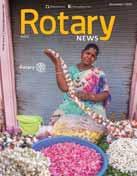
The front cover photo of a flower seller at Chennai is simple but attractive and Kiran Zehra’s cover story is heartrending. RI President Holger Knaack’s message gives positive energy to march forward with new opportunities from the pandemic and marks 2020 as a year of strength for Rotary.
Editor Rasheeda Bhagat calls for economic rehabilitation of low-income group post-Covid, with microfinance as a sustainable remedy. Delighted to read about the various signature projects implemented by RC Pune South, which turned 50. Articles like Challenges and opportunities for Rotarians
the doctors and medical students in Ethiopia and opened fixed deposits to help with the higher education of poor girls in the golden jubilee year. Let the club continue its journey in serving the community in more innovative ways.
Veeranna A Huggi RC Shimoga — D 3182
The work of social activist Mayank Gandhi (Nov issue) is praiseworthy. His work has enhanced
in a post-Covid world by K R Ravindran and Rallies, awareness campaigns mark World Polio Day are all worth reading.
Pleased to note that Rotary magazines are being published in 25 languages serving members in 129 countries. The write-up on Manna Dey is exemplary.Congratulations for the great work.
Philip Mulappone M T RC Trivandrum Suburban — D 3211
In the December issue, the Editor’s note urging Rotarians, who have done ample Covid-relief work, to give economic relief and rehabilitation to the poor is an eye-opener. Congratulations to Kiran for the cover story on Chennai’s flower sellers, and their plight during this pandemic. S R Madhu’s report on Manna Dey and V Muthukumaran’s article on pandemic relief by Rotarians were both fantastic.
Daniel Chittilappilly RC Kaloor — D 3201
the farmers’ income, thus improving their livelihood.
Two articles were interesting to read in the December issue. First, S R Madhu’s piece on Manna Dey, who has sung more than 4,000 songs, and got appreciation from Lata Mangeshkar for his exquisite rendition. My greetings to the writer for an excellent biography.
The second article RC Pune South turns 50 with a bang is noteworthy as it
completed a slew of projects covering health and hygiene, women’s empowerment, education and skilling. My kudos to the club. Dr Pon Muthaiyan RC Aduthurai — D 2981
RIPresident Holger Knaack’s message for the new year has changed all of my thinking about the year 2020. What a fantastic message he has given to all Rotarians. He has described how when the entire world
was at a standstill, Rotary was not. We are being innovative indeed.
Dr Mahesh Kawle, RC Karaikal Centennial — D 2982
The cover story in the November issue titled Community farming for a prosperous India was really inspiring. Mayank Gandhi’s work is admirable and astonishing, particularly in the days after demonetisation. His hard work has transformed the village economy. Kudos to him.
Vinayak N Upadhye RC Aurangabad — D 3132
In the November issue, the article about a Rotaractor Jaya Sagar who got help from RC Manali, RID 3070, is interesting to read. I am happy to know that the Manali club had donated a high-end computer to her for pursuing higher education in UK. Also, DG Davinder Singh has arranged for Rotarians in Bristol to contact her; how wonderful that this Rotaractor was helped in this way.
Hats off to club president G C Thakur and his team for doing this wonderful work. DG Singh’s effort in this project is appreciable. Let us make Rotaractors feel that Rotary is there to provide them help when needed.
N Jagatheesan RC Eluru — D 3020
An inspiring true story
The article by PDG Rajan Deshpande ( A Rotarian doctor recalls his brush with coronavirus ) was not only a call not to take the pandemic lightly, but also an inspirational true story. He has recalled the events in a simple manner which ensured the readers were able to connect with the situation well.
The article rightly points out the pandemic has taken a toll on daily lives
of people and health professionals are really exposed to the danger of this infection, despite taking precautions. Giving a bright light of hope for Rotarians and leading by example, Deshpande gives importance on spending time with loved ones and cherishing our dreams, which is also a core value of Rotary. This article was an inspiration to pursue our lives with great spirit and passion.
Dr Jayasekharan V P
RC Payyanur — D 3202
At the outset, I must congratulate Editor Rasheeda Bhagat for presenting us such a beautiful monthly magazine, with so many excellent articles. In the November issue, PDG Dr Rajan Deshpande has narrated the seriousness of the Covid virus and how he escaped from the jaws of death, after getting infected. I would request those eligible, who are cured from corona, to give back plasma in gratitude for life.
PDG N K Mishra — D 3262
Know your health numbers
Rotary clubs must hold ‘Know your numbers’ camps to monitor the weight, BP and blood sugar regularly in people and exhort every adult to know his three main health
numbers. These camps are inexpensive and easy to organise.
During the camps, health literature pertaining to importance of having the right numbers — BP measuring 120/80, BMI less than 25, fasting blood sugar less than 100 and post-lunch sugar less than 140 must be emphasised. Let us distribute brochures containing simple tips to control diabetes, BP, heart disease, stroke and kidney failure with suggestions for a healthy lifestyle.
Govinddas Agrawal
RC Belur — D 3291
A Rotary info plus
Rotary News Plus is as good and informative as ever. My best wishes to the editorial team.
Arun Kapur past district governor — D 3070
A ray of hope
With reference to your editorial, we hope Rotarians can act as a bridge between financial institutions and poor beneficiaries. They can play an important role in training the poor and unskilled to improve their livelihoods, working in partnership with local banks and governments.
Govind Sharma RC Khandwa — D 3040
We welcome your feedback. Write to the Editor: rotarynews@rosaonline.org; rushbhagat@gmail.com. Mail your project details, along with hi-res photos, to rotarynewsmagazine@gmail.com
Messages on your club/district projects, information and links on zoom meetings/ webinar should be sent only by e-mail to the Editor at rushbhagat@gmail.com or rotarynewsmagazine@gmail.com WHATSAPP MESSAGES WILL NOT BE ENTERTAINED.
Click on Rotary News Plus in our website www.rotarynewsonline.org to read about more Rotary projects.

anuary is finally here. As we look forward to 2021, our thinking doesn’t have to stop at the end of these 365 days. Are you thinking ahead about what you will be doing in 2022, 2023, and beyond?
We cannot foresee the future, but we can steer ourselves where we want to go. I think it is important that every Rotary club hold a strategic meeting at least once a year. Past RI Director Greg Yank, who has a lot of experience working with clubs on their plans, shares his viewpoint.
A famous aphorism states,“By failing to prepare, you are preparing to fail.” Planning is essential to achieving success in all areas of life, including Rotary, and we’re getting better at it every year.
Strategic planning for Rotary clubs works. I have helped many clubs find that pathway by working with them to build what I call a blueprint, a multiyear plan that answers the fundamental question: “What is our vision for our club?” The best plans I have seen are those that are focused, when a club concentrates its resources on the best opportunities it has. Your Rotary club cannot be all things to its members and to the community it serves; it has limited human, financial and time resources. A successful plan factors in assets and limitations to chart the desired pathway for your members.
Begin building a multiyear strategic plan by brainstorming with your club, asking, “What are our initiatives and priorities for the next two to three years?” Document your answers using actionoriented language that is specific, concrete and measurable about the goals you want to achieve.
Next, narrow down your initiatives to a core set of three to five priorities. Your club will then develop specific objectives for each initiative, outlining who will be involved, key milestones of achievement, how progress will be tracked and a timeline for completion. Keep your plan short and simple.
Then go out and do it. Review the progress you make toward accomplishing the initiatives, and revise as needed at least once a year. Rotary has a solid template to assist clubs in their planning, which you can find at my.rotary.org/document/ strategic-planning-guide.
We want to enrich and enliven our clubs with new discussions and ideas. But how do we attract the diverse professionals, from different backgrounds, ages and experiences, who are all driven by as strong a sense of integrity as we are?
Through strategic planning, we explore this question to define the very nature of our club and the value it offers to its members and to the community. Each club is different, and each club’s value will be unique. During the planning process, clubs may also find that some of the activities they used to do are no longer relevant or attractive.
Once your club makes a strategic plan, it’s time to take action and carry out the necessary changes. When we do that — as we engage members in vibrant and active clubs that not only have fun but also serve their communities with projects that have real and lasting impact — our clubs grow stronger. And when we discover what makes our own clubs unique and build upon those core values in all our efforts, Rotary Opens Opportunities to enrich the lives of everyone.
Holger Knaack President, Rotary International


As this, the most uncertain, horrendous, terrifying and devastating year in my living memory, comes to a close, I wonder if there are even a handful of people across the world who would be sad to see 2020 coming to a close. Aptly enough, a December issue of Time magazine, has on its cover ‘2020’ written in bold letters with a huge X mark across the entire image. Just as the entire world was seeing some rays of hope in the form of fairly reliable and safe vaccines to protect us against the Covid-19 infection, came news of a new, and possibly more dangerous, mutant of the coronavirus, seen in Europe, particularly the United Kingdom. Once again, the rigmarole of partial lockdowns, banning flights from UK, testing people who have come from there recently for not only the coronavirus, but this new form of it, has begun. Just as the new year was offering hope, the clouds have loomed on the horizon yet again.
And yet, 2020, the dismal year that it was, gave all of us the time to pause and reflect on our lives and lifestyle. It was also filled with numerous stories of hope and courage, generosity and compassion, selflessness and the willingness of so many people, to step out of their comfort zones, and stick out their necks, and risk getting infected, to help the poor and needy. The way Indians across the board responded… from the women in Surat’s residential colonies, each of whom willingly rolled out 5–6 extra chapattis every day, which were collected and then given to stranded migrant labourers, to those who opened their hearts and purses, including so many Rotarians, to feed
the homeless and the stranded, restored our faith in humanity.
So what will the new year bring? Will it be better or worse than this one? Well, there is no crystal ball to tell us what the future holds for this planet. But one thing this pandemic, and the horror and immense fear of this tiny virus, has done, is make us pause in our hectic, often directionless lives, targeted at achieving new goals in our careers or new highs in our bank balances. Pause and wonder, if all that we have been doing is worth it. Just one example is enough to give an idea of the immense greed and selfishness of the homo sapiens, not only in grabbing the best for themselves and amassing wealth, but also in plundering our planet’s flora and fauna. We had to just retreat into our homes and lock ourselves away in fear, drastically reducing our carbon footprint as the world’s jet planes and automobiles were locked away in their hangars/ garages, for the flowers to bloom, the green foliage to regain its splendour and the animal life to slowly emerge from where we had relegated it, to reclaim its rightful place on our planet.
Whatever 2021 brings, in terms of vaccines and protection against this or other viruses, better and more equitably distributed healthcare, ‘normalisation’ of life as we have known it and a whole host of opportunities that our world is waiting for, if this virus has taught us some lessons and helped us become better human beings, then in some supreme power’s scheme of things, it would be classified as the great leveller on so many different counts.
Rasheeda Bhagat
RI Dist 2981
RI Dist 2982
RI Dist 3000
RI Dist 3011
RI Dist 3012
RI Dist 3020
RI Dist 3030
RI Dist 3040
RI Dist 3053
RI Dist 3054
RI Dist 3060
RI Dist 3070
RI Dist 3080
RI Dist 3090
RI Dist 3100
RI Dist 3110
RI Dist 3120
RI Dist 3131
RI Dist 3132
RI Dist 3141
RI Dist 3142
RI Dist 3150
RI Dist 3160
RI Dist 3170
RI Dist 3181
RI Dist 3182
DG R Balaji Babu
DG K S Venkatesan
DG A L Chokkalingam
DG Sanjiv Rai Mehra
DG Alok Gupta
DG Muttavarapu Satish Babu
DG Shabbir Shakir
DG Gajendra Singh Narang
DG Harish Kumar Gaur
DG Rajesh Agarwal
DG Prashant Harivallabh Jani
DG CA Davinder Singh
DG Ramesh Bajaj
DG Vijay Arora
DG Manish Sharda
DG Dinesh Chandra Shukla
DG Karunesh Kumar Srivastava
DG Rashmi Vinay Kulkarni
DG Harish Motwani
DG Sunnil Mehra
DG Dr Sandeep Kadam
DG Nalla Venkata Hanmanth Reddy
DG B Chinnapa Reddy
DG Sangram Vishnu Patil
DG M Ranganath Bhat
DG B Rajarama Bhat
RI Dist 3190 DG B L Nagendra Prasad
RI Dist 3201 DG Jose Chacko Madhavassery
RI Dist 3202 DG Dr Hari Krishnan Nambiar
RI Dist 3211 DG Dr Thomas Vavanikunnel
RI Dist 3212 DG P N B Murugadoss
RI Dist 3231 DG K Pandian
RI Dist 3232
RI Dist 3240
DG S Muthupalaniappan
DG Subhasish Chatterjee
RI Dist 3250 DG Rajan Gandotra
RI Dist 3261 DG Fakir Charan Mohanty
RI Dist 3262
RI Dist 3291
DG Saumya Rajan Mishra
DG Sudip Mukherjee
Printed by P T Prabhakar at Rasi Graphics Pvt Ltd, 40, Peters Road, Royapettah, Chennai - 600 014, India, and published by P T Prabhakar on behalf of Rotary News Trust from Dugar Towers, 3rd Flr, 34, Marshalls Road, Egmore, Chennai 600 008. Editor: Rasheeda Bhagat.
The views expressed by contributors are not necessarily those of the Editor or Trustees of Rotary News Trust (RNT) or Rotary International (RI). No liability can be accepted for any loss arising from editorial or advertisement content. Contributions – original content – are welcome but the Editor reserves the right to edit for clarity or length. Content can be reproduced with permissionand attributed to RNT.
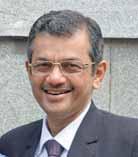
WhenI joined Rotary, it was like moving into a new house — a house with four large, beautiful windows, each offering a different and striking view. One window led directly to my newfound friends — lawyers, architects, bankers, businessmen and others. Another window led straight into the heart of the community. The third opened onto a broad avenue that led out of my community, my country to different parts of the world. But it was the fourth window that fascinated me. The glass of this window was like a two-way mirror — one offered a view outside allowing me to offer my vocational expertise to my club and community. But it also gave me a glimpse into my own self; my attitude, thinking and actions. Yes, the three windows are club, community and international service windows. But the fourth was very important — Rotary’s vocational service, reflecting and depicting the very core of Rotary. It is the true window to Rotary’s soul which has brought credibility to Rotary.
When I was club president, Bob Barth was the RI president. He once said the Rotary pin should say about the wearer — ‘You can rely on me, I am dependable, reliable, give more than I take, I am available’. These words apply to all aspects of Rotary but especially to our vocational service.
January is vocational service month, a good time to focus on vocational service in our club projects and activities. It is this that clearly and sharply differentiates Rotary from other service organisations, as our membership is based on our vocations. It is about sharing and learning about each other’s vocation; using our professional skills to serve; mentoring the young, recognising outstanding individuals and integrity in our personal, professional and Rotary lives. It calls on us to empower others, especially youth, by using our unique skills and expertise to help them discover new professional opportunities and interests. Vocational excellence and integrity are two intertwined parts of Rotary’s vocational service. By recognising individuals who practice their profession/vocation with passion, pursuit of excellence, perseverance and integrity through rewards, Rotary seeks to encourage and motivate them and set an example for others to follow. This is a good way to celebrate vocational service month.
Values are intrinsic to our lives. They add strength to our character. I had a dream in which God said to me, ‘Just build a better world.’ ‘How?’ I asked, ‘The world is a vast and complicated place. And I am so small and insignificant.’ And God in His wisdom said, ‘Just build a better You’. Let us build ourselves better so that we can make our clubs better and the community a better place to live in. That is our vocational opportunity. The greatest reward for doing good is the opportunity to do more. Grab that opportunity. Enjoy Rotary, enjoy yourself.

2019–21
Dear Rotary leaders,
“Ethics is knowing the difference between what you have the right to do And what is the right thing to do.”
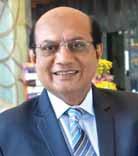
Vocational Service asks us to empower others by using our unique skills and expertise to address community needs and help others discover new professional opportunities and interests. January is Rotary’s Vocational Service Month, a great time to leverage vocational service in your club projects and activities, imbibing the spirit of our Four-way test.
I urge each one of you to practise vocational excellence on two fronts — your personal contribution and commitment and secondly, through your club activities.
Five ways you can incorporate vocational service in your club activities:
• Help devote a meeting in January to examine the second avenue of service, including the Four-way test and the Declaration of Rotarians in business and professions.
• Introduce a ‘mini classifications talk’ series in which each member gives a five-minute talk on his or her vocation.
• Present a vocational award to someone in the community who has exemplified outstanding professional achievement while maintaining very high ethical standards.
• Invite experts to give a presentation on the vocational needs of the community and develop a project in response to those needs. Possible projects could focus on developing character, providing career information to youth, mentoring small businesses, or organising workshops that provide employees with new skills.
• Encourage club members to put their vocational skills to work as a Rotary volunteer.
Five ways you can incorporate vocational service in your personal capacity:
• Join a Rotarian Action Group and support service projects across the world.
• Practise your profession with integrity, and inspire others to behave ethically through your words and actions.
• Work with local businesses to create mentorship, internship, or practicum opportunities to help young people achieve their career goals.
• Guide and encourage others in their professional development.
• Participate in a vocation related Rotary friendship exchange
Let us strive not to become a man/woman of success, but rather a man/woman of value.

Kamal Sanghvi RI Director, 2019–21
Board of Permanent Trustees & Executive Committee
PRIP Rajendra K Saboo RI Dist 3080
PRIP Kalyan Banerjee RI Dist 3060
RIPE Shekhar Mehta RI Dist 3291
PRID Panduranga Setty RI Dist 3190
PRID Sushil Gupta RI Dist 3011
PRID Ashok Mahajan RI Dist 3141
PRID P T Prabhakar RI Dist 3232
PRID Dr Manoj D Desai RI Dist 3060
PRID C Basker RI Dist 3000
TRF Trustee Gulam A Vahanvaty RI Dist 3141
RID Dr Bharat Pandya RI Dist 3141
RID Kamal Sanghvi RI Dist 3250
RIDE A S Venkatesh RI Dist 3232
RIDE Dr Mahesh Kotbagi RI Dist 3131
Executive Committee Members (2020–21)
DG Sanjiv Rai Mehra RI Dist 3011
Chair – Governors Council
DG Sudip Mukherjee RI Dist 3291
Secretary – Governors Council
DG Sangram Vishnu Patil RI Dist 3170
Secretary – Executive Committee
DG Prashant Harivallabh Jani RI Dist 3060
Treasurer – Executive Committee
DG S Muthupalaniappan RI Dist 3232
Member – Advisory Committee
ROTARY NEWS / ROTARY SAMACHAR Editor Rasheeda Bhagat Senior Assistant Editor Jaishree Padmanabhan
ROTARY NEWS TRUST 3rd Floor, Dugar Towers, 34 Marshalls Road, Egmore Chennai 600 008, India. Phone : 044 42145666
e-mail: rotarynews@rosaonline.org Website: www.rotarynewsonline.org
Now share articles from rotarynewsonline.org on WhatsApp.








Bharat Pandya

s we ended a year wrecked by the Covid pandemic I am reminded of the famous book by Charles Dickens A Tale of Two Cities which begins thus:
“It was the best of times, it was the worst of times;
It was the season of light, it was the season of darkness;
It was the spring of hope, it was the winter of despair.”
These lines capture the essence of the year 2020. A year which started with a lot of promise and hope. Hope of Rotary connections and Rotary opportunities. But the



year descended into darkness and despair as the Covid pandemic struck, bringing the world to its knees.
In my 44 years of association with the medical profession — as a student, intern, resident and then consultant, I haven’t seen such despair, denial, fear and mental anguish, as this pandemic has caused. As a frontline healthcare professional in this Covid crisis
I have seen people’s reaction ranging from incredulity — ‘Who me? Covid? Can’t be’; to fear and shock ‘Why me?’; to stigma and social boycott ‘Oh! He/she has Covid’. People and housing











societies formed their own rules and parameters, often unrealistic and irrelevant but enforced strictly nonetheless.
Amidst all these rational and irrational reactions and stories of misery of the migrant workers, homelessness and hunger, there were plenty of rays of hope.



you have, but what you do with whatever you have, that matters.” As Emerson says, “Without a rich heart, wealth is ugly.” And so many people around the world, many of them Rotarians have really shown a rich heart in these trying times.


care equipment and the inadequacies of public services.
Like the doctor couple in Jaipur themselves preparing masks for free distribution to the poor; or the J & K cop whose rap jingle on corona went viral; or the Tata group which supplied free food packets to health workers in Mumbai for months on end during the times food was not available due to the lockdown. Hats off to the health workers and other frontline essential workers who kept the world running often at great risk to themselves and their families. These and many such stories of hope and sacrifice restore our faith in humanity. These and many others like them are the unsung heroes of these pandemic times. Many of these stories are the stories of Rotary and Rotarians.

Ibelieve that richness is a state of our mind. If a person has lot of money, that person may be wealthy but not necessarily rich. If a person has no money, he may be broke, but is not necessarily poor. As my dad used to tell me: “It’s not how much
The pandemic has shown that this crisis is fuelled by poverty, weak health systems and lack of safe water, sanitation, education and global cooperation. The Covid-19 crisis has put a harsh spotlight on a number of issues and problems — on the lack of preparedness of countries, many of whom were caught unawares, on the neglect of public health systems and on the sheer apathy and denial of many world leaders and good parts of the population who chose to go about ‘business as usual’. This has come as a shock to all countries and has exposed vulnerabilities of vital supply chains, lack of availability or deployment of critical




There are some pluses: better environment, more scientific collaboration, quicker breakthroughs, improved communication, positive and good use of the virtual communication medium and the world becoming truly a global village. The world has to now make the right choices in its path to recovery.
The pandemic has shown that this crisis is fuelled by poverty, weak health systems and lack of safe water, sanitation, education and global cooperation.






Closer home in India where public healthcare spending is just 1.3 per cent of the GDP we realise the importance of making the public healthcare system more robust and better equipped to face future pandemics, should they occur, when they occur. Not just well-trained doctors and nurses but properly trained paramedics, vaccinators, lab technicians, Asha workers and other support staff, along with adequate ICU beds and critical care infrastructure, are all needed. Building this infrastructure will not only ensure good and proper response to such crises but also ensure better outcomes in routine healthcare including the fight against NCDs. The added bonus would be more and better job opportunities for the youth.
We are always comfortable with old problems rather than new





solutions. The Covid pandemic has shattered the status quo. It has thrust a new, ever-changing world upon us. In this new world it has brought home to us some vital issues:
• No one can be left behind, even if a small group is left unprotected, the pandemic can and will resurge.
• It affects all; rich and poor, urban and rural, haves and have-nots equally.
• It requires tackling and response at the local, national and global level.
• The challenges of positive health, hunger and poverty alleviation, productive work, quality education, climate change and environment cannot be dealt with in isolation or by a piecemeal approach. The world has to unite and work in cooperation and a sense of partnership to deal with these issues.
AsI write this article, there are rays of hope. At least six countries have given approval for emergency use of the mRNA vaccine. And some more vaccines are in the final stages of approval for emergency use. Many more vaccines will become available in the coming months. That is good news.
We all owe a big thanks to Edward Jenner who in 1796 introduced the concept of vaccination
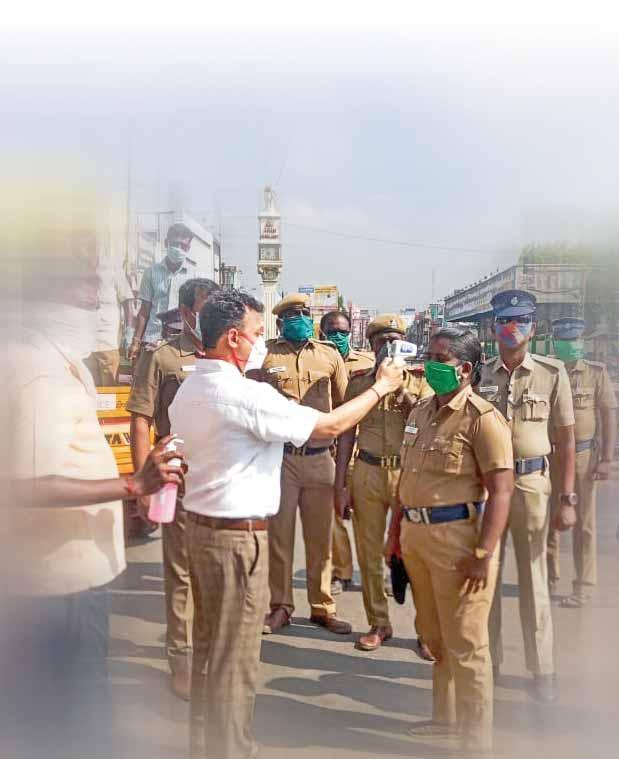
RC Vriddhachalam past president A Deepak Chand and his team check the body temperature of police personnel.
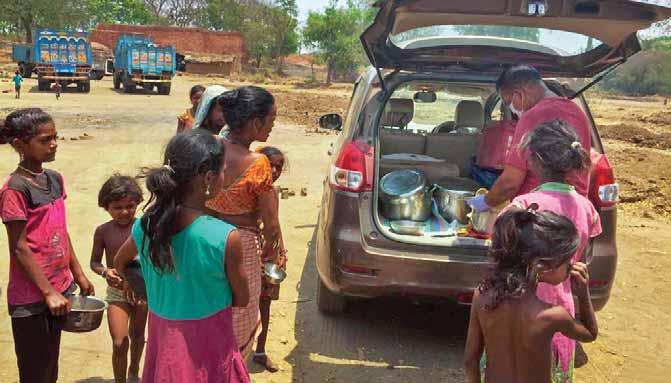
RC Mumbai Queen’s Neckalce distributes food for the needy during the pandemic lockdown.
against smallpox. The smallpox vaccine travelling from London through Vienna, Baghdad, Basra, finally reached Bombay in 1802. And this journey culminated with the eradication of smallpox nearly two centuries later in 1980 when the world was declared smallpox-free by WHO.
The Spanish flu pandemic started in 1918 and the vaccine became available for use 27 years later in 1945. The polio vaccine took over 10 years to be approved for use. For the Covid pandemic, vaccines are available in less than a year’s time. This is Hope in Action. We are bruised but not beaten. There is now light at the end of the tunnel.
The road ahead will be long and arduous. Vaccinating over seven billion people worldwide is a herculean task, one which will require partnerships and close working relationships between all world governments, WHO, other UN organisations and civil society
As hope springs anew with the availability of effective vaccines, a new door of opportunity opens before us in Rotary to play our part.
including service organisations like Rotary, the Gates Foundation and every NGO — small and big. The aim should be equitable vaccination of all populations irrespective of socioeconomic status, caste, creed and religion. Another challenge will be to overcome the misinformation and resistance to vaccination.
The Rotary International Board has just approved Rotary’s involvement in the Covid-19 response. The board encourages Rotary clubs and Rotarians to look at and try to meet local needs vis-a-vis vaccination,
apart from an advocacy role. As president nominee Jennifer Jones points out, there is synergy between the Covid vaccination initiative and polio immunisation. This is like the ‘plus’ in PolioPlus. Rotarians have proved with polio that if we dare to dream and work with an action plan to follow that dream, we can create miracles. Rotary is both hope and opportunity. This is our time and this is our moment. As hope springs anew with the availability of effective vaccines, a new door of opportunity opens before us in Rotary to play our part. Let’s grasp it. Together we can, and we will once again make this the best of times, the season of light and the spring of hope.
The writer is a serving Rotary International Director.
Designed by Krishnapratheesh S
During his tenure as governor of RID 3211 (2017–18), Suresh Mathew had the dream to take on an ambitious district project with several components, to which he and his team gave the acronym
HOPE (Hospital Projects and Equipment).
Even though ranking relatively high on the human development index when it comes to Indian states, “Kerala has a high incidence of lifestyle diseases such as diabetes, hypertension,
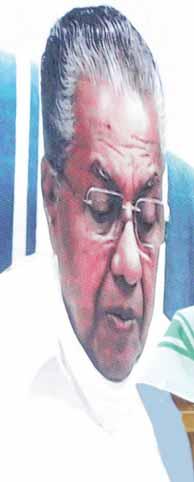
heart diseases and cancer, and I felt we should help the Kerala government contain these diseases by providing diagnostic and other equipment,” says Mathew.
As his year drew to a close, “I was on the lookout for a grand
final signature project of scale under HOPE, and shared this idea with a few passionate presidents and offered district grant support.” Accepting the gauntlet, president of RC Trivandrum Kowdiar, Dr P Mangalanandan, a senior cardiologist of


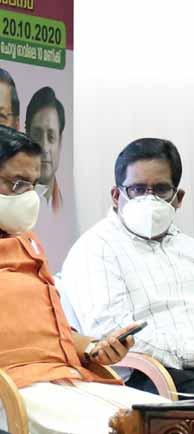
Thiruvananthapuram, conducted a needs assessment survey in government hospitals. He found that with breast cancer being the most common cancer in women, there was a pressing need for mammography equipment in the government sector.
Apart from the fact that early detection can cause quicker and better recovery, “there was also evidence that in India breast cancer was seen to be more common and aggressive in relatively younger women — those in their thirties and forties, unlike western countries where it is more
commonly seen in women in the 40–50 age group and above. As, during their 30s and 40s, women are really busy with their families and their own careers, if detected late, lengthy treatment cycles have great psychological and financial impact, devastating many families,” says Dr Mangalanandan, who was designated project chair of the Rotary Digital Mammography project.
He adds that this is the reason why many cancer organisations, including the American Cancer Association, recommends regular screening of women in the age group 40–55 years. However, due to lack of awareness
The incidence of breast cancer in Kerala is higher than the national average, and even in Kerala, the numbers were higher in Thiruvananthapuram.
or availability of mammography equipment, breast cancer is often detected at a relatively later stage in India, pushing up mortality rates.
modern digital mammography equipment in a premier government institution — the Government Medical College (GMC) at Thiruvananthapuram. This was chosen as it caters to a large chunk of the population from South Kerala and even Tamil Nadu. This institute is also manned by a sufficient number of radiologists, post graduate students, radiographers and trainees, ensuring adequate manpower to effectively use the equipment.
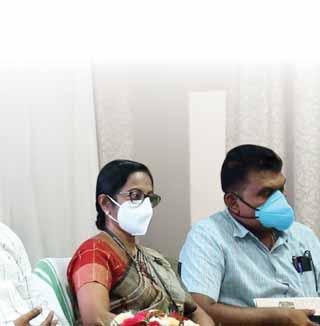
Kerala chief minister Pinarayi Vijayan (left) addressed the inaugural session online. Seated on the dais are DG Thomas Vavanikunnel; Kadakampalli Surendran, minister for Tourism; PDG Suresh Mathew, Dr Sara Varghese, principal, Trivandrum Medical College and Dr Sharmad, the college superintendent.

Mathew adds that the groundwork done by the Rotarians also found that the incidence of breast cancer in Kerala is higher than the national average, and even in Kerala, the numbers were higher in Thiruvananthapuram. “We found that there was no facility or programme for mass screening for breast cancer in the whole of Kerala. In Thiruvananthapuram, the only digital mammography facility was at the Regional Cancer Centre, where it was used more for planning treatment, rather than screening. The facilities in the private sector comprised only analogue machines, and the cost of mammography ranges from `2,000–3,000, making it unaffordable to the masses.”
Once the pressing need for more mammography equipment in the region was determined, RC Trivandrum Kowdiar sprang into action and took up the task of installing
The Rotarians zeroed in on the latest diagnostic equipment in mammography which is digital in nature and turns out images of superior quality. Senographe Crystal Nova, the machine from General Electric, the latest in the international market, was chosen. “I understand this was the first such model to be ordered from India. We bargained down the price from the quoted `1.2 crore to `1.08 crore, but still, that was a daunting amount for doing any project in RID 3211. Finding that much money was a herculean task,” admits PDG Mathew.
But he was optimistic that the money would be

Past president Rajesh, who is the grandson of the first principal of Trivandrum Medical College, volunteered to donate the seed money of `10 lakh. This was a great morale booster for our club’s leaders.
Dr Mangalanandan
found. “It was then that one of our past presidents, Rajesh, who is the grandson of the first principal of Trivandrum Medical College, volunteered to donate the seed money of `10 lakh. This was a great morale booster for our club’s leaders and Rajesh’s donation created momentum and a few other Rotarians including the club president promised funding support,” says Dr Mangalanandan.
Still there was a huge shortfall; but the money started coming. At the district training assembly, DG
Mathew’s wife, Liya Mathew, made a personal donation of `5 lakh. Mathew allocated 50 per cent of the district designated fund of 2017–18, and district CSR chair G N Nair, a member of RC Trivandrum Central, a chartered account who has served as MD of various government-owned corporations, was given the responsibility to raise the remaining money.
Using his clout with the ministers, and presenting a detailed project report to the state finance minister Dr Thomas Issac, Nair persuaded the minister’s personal intervention to get a CSR sum of `25 lakh from the Kerala State Financial Enterprises, an undertaking of the Kerala government.
“This was history in the making as this was the first ever CSR contribution received by our district. Additional CSR funds came from UST Global, a technology unicorn based at the Trivandrum Technopark. Other companies like Terumo Penpol and Sahajanand Technologies also came forward to support the project, and members of RC Kowdiar also contributed generously,” adds Mathew.
Even after overcoming the financial hurdle, there were several technical and other delays in getting and installing the equipment. When these were removed, came the Covid pandemic to cause further delay. But the Rotarians worked closely with both the government and media to overcome all glitches and “finally, on Oct 20, the equipment was dedicated to the public by Chief Minister of Kerala, Pinarayi Vijayan, at a meeting attended by two Kerala ministers and MP Shashi Tharoor. DG Thomas Vavanikunnel, PDG Mathew and Dr Mangalanandan were present.
But the district’s Rotarians can hardly rest after this mega project. Adds Mathew: “After the inauguration, while interacting with the doctors, one of the senior doctors at MCH had a very simple request. ‘We have a real problem here; we need a PET scan equipment urgently.’ When I asked her how much would it cost, she said `19 crore!”
Well, there is no shortage of doing good in the world for determined Rotarians!

Having grown up amid lush green forests in the mountainous landscape of Sri Lanka, I always recall the words of the great poet Rabindranath Tagore: “Trees are the earth’s endless effort to speak to the listening heaven.”
How sad that so often we humans insist on interrupting this conversation.
Just like every other living thing, we are a part of nature. But we are also the only species that bears the responsibility of protecting the environment for future generations. The coronavirus pandemic has shed light as nothing has before on the relationship between environmental degradation and threats to public health.
A few years ago, the government-owned electricity company in my country planned to build a second coal power plant in eastern Sri Lanka. It would suck 93 million litres of water per hour from a bay where fragile ecosystems meet the deep sea, the site of one of the largest spawning grounds for sperm whales in the world. After processing, those 93 million litres per hour would be dumped into the ocean, now loaded with toxic chemicals that put that marine life at great risk.
Learning from the lessons of the damage caused by the first plant, a coalition formed, made up of many public advocates, including Rotarians. They ran a campaign that alerted the media, the public, and the local community to the potential dangers, in addition to taking legal action. The government eventually abandoned its coal plant idea after the resulting public outcry.
We can truly move mountains when we come together.
When some of us moved to add the environment as Rotary’s newest cause, we did so because of the urgency of the problem. In 1990–91, RI President Paulo V C Costa set forth a vision, and today we will take this work to the next level. We live in a time of great stress on our environment, of rapidly rising sea levels, massive storms, disappearing rainforests and wildlife, and destructive forest fires. Climate change touches us all, rich and poor.
We will face the challenge strategically, as with the other areas of focus. In fact, the six other areas of focus depend on this one. For what good is it to fight disease if our polluted environment causes us to become sick again?
The Rotary Foundation will be central to this work. More than $18 million has gone toward environment-related global grants in the past five years. Building upon this work to protect the environment, we will give yet another Rotary gift to future generations. And you can be a part of it today.

Taiwan’s food, like its people, mostly has roots in China, but over the generations, the Taiwanese have developed their own versions of dishes. When you are in Taipei for the Rotary International Convention from June 12 to 16, don’t miss the chance to sample some of Taiwan’s signature fare.
Beef noodle soup (niu rou mian) is the unofficial national dish of Taiwan. The soup draws on the spicy flavours of China’s Sichuan province. Star anise, cloves, cinnamon, Sichuan pepper, and fennel seeds help create a rich and spicy broth that coats the noodles, which are accompanied by slices of tender beef shank and bright greens.
Where to eat it:
• Tao Yuan Street Beef Noodles, 15 Taoyuan St, Zhongzheng district
• Yong Kang Beef Noodles, No 17, Lane 31, Section 2, Jinshan South Road, Da’an district
Soup dumplings (xiao long bao) originated in the city of Nanxiang, China, but Taiwan is known for producing dumplings with a thinner, more delicate skin than the mainland versions. The dumplings are traditionally stuffed with pork but can also contain crab, chicken, or other meaty substitutes. The “soup” part of the dumpling is a gelatinous broth that melts when the dumpling is steamed. Be cautious when biting into a soup dumpling, because it is easy to burn your tongue or to let the delicious soup spill out onto your plate. For best results, place a dumpling on a spoon, take a nibble out of the side, and let it cool a bit before sucking the broth out. Where to eat them:
• Din Tai Fung, a chain famous for its soup dumplings, has multiple locations in Taipei. Check the English version of its website at www.dintaifung. com.tw/eng.
K R Ravindran Foundation Trustee Chair
Learn more and register at Convention.rotary.org

(As on December 1, 2020)














Rotary clubs : 36,423
Rotaract clubs : 11,171 *RCCs : 11,458
Interact clubs : 15,381
Rotary members : 1,193,852 Rotaract members : 213,269 Interact members : 353,763 As on 16 December 2020























Rasheeda Bhagat
When the strapping young Srikanth, an engineering undergraduate just beginning his career in Hyderabad, was on his way to his grandmother’s house on his 26 th birthday on Sep 24 to seek her blessings, fate had other plans for him.
He was riding a motorbike and a dog suddenly ran across his path,
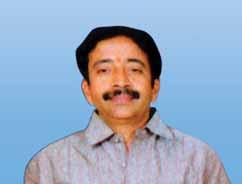
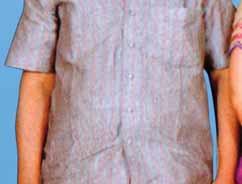
right in front of his two-wheeler. In an effort to try and save it, he swerved wildly and crashed on the road, sustaining grievous head injuries.
Srikanth, the son of Bikkina Chakravarthi, a past president of RC Mandapeta, who has also been an assistant governor of RID 3020, was hospitalised for 25 days, and even though he valiantly fought his
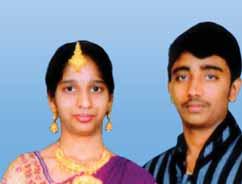
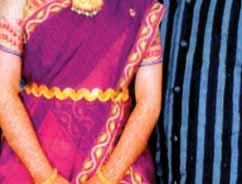

injuries after undergoing surgery at the Global Hospital, Hyderabad, several post-operative complications left him brain-dead, leaving his father, mother Bhanu and sister Srilekha in a whirlpool of sorrow and pain.
But even though engulfed in the deep pain of having lost her young son, his mother Bhanu plucked up the courage to discuss with
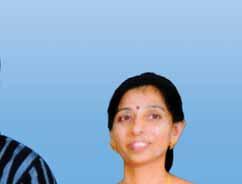
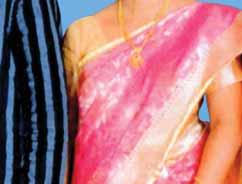
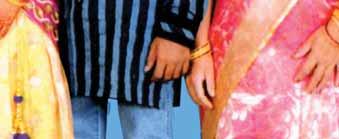

My wife and I decided that even though
Rtn Bikkina Chakravarthi
Chakravarthi the possibility of donating their son’s organs under the Telangana government’s Jeevandan (cadaver transplant scheme) so that even in his death the youngster could help others.
The father readily agreed, and in the third week of October, Srikanth’s heart, two kidneys and liver were donated, giving a new
lease of life to four people. The recipients included another 26-year-old youth, suffering from a weak heart, who has now got a healthy, strong heart ticking in his chest cavity, thanks to the generosity and timely intervention of Srikanth’s parents.

Speaking to Rotary News Chakravarthi said his son was not only absolutely healthy but also full of life and joy and had a huge circle of friends. “My wife and I decided that even though we were grieving and mourning his loss, and our suffering would be lifelong, we had it in our power to make four other families happy. That gave us some happiness.” They would have loved to know who were the recipients of their son’s heart and other organs, “but privacy laws of the government do not allow the hospital to reveal that information.”
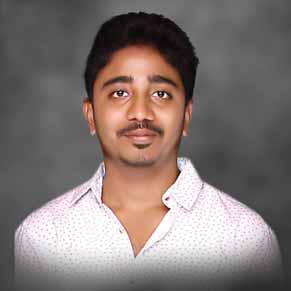
Srikanth’s parents are still learning about the special qualities of his son, a Paul Harris Fellow. “His friends are now telling us that he was
extremely generous and kind-hearted, and if anybody needed any help, he would not hesitate to do his best to help them.”
Srilekha, his sister, says she misses her brother terribly, and can never forget his love for food and passion for music. “He would eat all kinds of food, including junk food and was very fond of different kinds of music, particularly film songs and classical music.”
But along with her parents, she too is happy that her brother lives on in four others and this gesture of her parents will bring them and her a sense of peace.

Jaishree

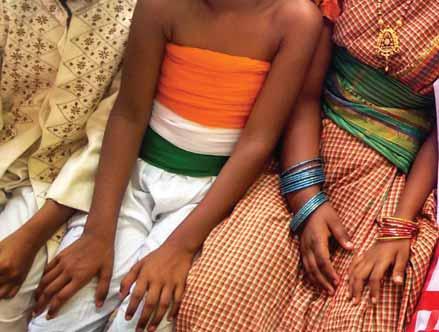
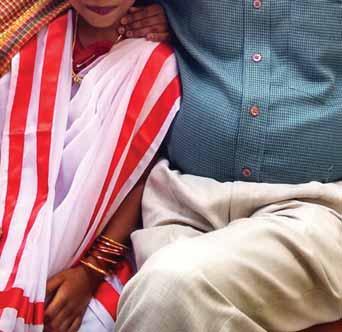
The Bangalore Little Theatre (BLT), one of Bengaluru’s first English theatre groups, is celebrating its diamond jubilee this year. Vijay Padaki, a member of RC Bangalore, RID 3190, is its founder-trustee. He is also assisting RCB in setting up its own theatre club.
Padaki is a psychologist and behavioural scientist, a founding faculty member of IIM Bangalore and a visiting professor for R&D management at the IISc Bangalore. He started his journey in theatre at 20 and has written over 50 original plays in English, besides several adaptations and translations, over a span of 60 years with BLT. Padaki has been an actor, director, trainer, writer, designer and administrator. He institutionalised several activities of BLT, such as the annual summer workshop for newcomers to the theatre (SPOT), from which
has emerged a large number of theatre personalities in Bangalore, the History of Ideas programme of biographical plays, the Courtyard Theatre and the Children’s Theatre programmes, and has also helped forge several international partnerships over the years.
As an ode to Padaki’s valuable contributions to theatre, BLT is publishing all his plays over nine volumes and last year, on his 80th birthday, it felicitated him by staging a festival of his plays across six months.
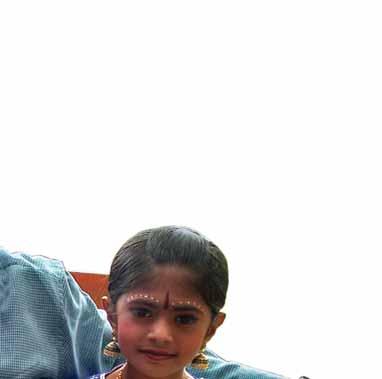
English language theatre can be expected to grow in India. There is more interest in writing for the stage now than 20 years ago.
Here are excerpts from his interview with Rotary News: How did you develop an interest in theatre and tell us about your journey with BLT.
I had the good fortune of having two outstanding mentors at a formative stage in my life. The first was a Professor of Drama during my college years in Madras, a Scotsman, who was also a dramaturg. He introduced me to serious drama beyond college skits. The second was one of the founders of BLT, Scott Tod (another Scotsman), who introduced high quality acting and directing into the amateur drama scene in Bangalore. Both of them took me under their wings, one after the other, and encouraged me to pursue drama seriously.
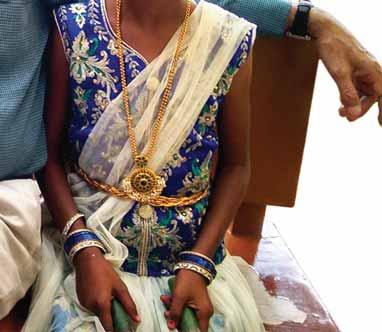
How do you conceive ideas for your plays?
I can think of two types of influence. The first is from my training as a psychologist. It made me accept the reality of diversity in human behaviour, and to even respect that. This means that all pigeon-holing of people is invalid and unhelpful. It is terribly important to look for what is unique in a person, what

is not always revealed — in the character as well as the actor playing the part.
The second influence is my instinctual search for a rhythm to things — in the words spoken, the moves, the flow through scenes, and so on. I find myself attending to this aspect of rhythm quite a bit in my productions. And I find myself easily bored when a production doesn’t get out of the “stuck record” rhythm!
Some of your most memorable plays?
It is very difficult to choose one piece to hold up. This is especially because I have always taken on different types of dramatic material, in different genres, exploring different forms and staging approaches. One of the best compliments I have received was that no two plays of mine have been the same — either as scripts or performances.
I can say, however, that in my early years as an actor, I really enjoyed finding the layers within layers of meaning in the part of the Father in the Pirandello classic, Six Characters in Search of an Author. I have played that part twice, in two different productions! As a director, I really enjoyed putting together a massive Children’s Theatre production. The play was Rigmarole by Sai Paranjpye.
What are your plans for the theatre club of RC Bangalore? Will the club train budding artistes; will it organise shows to help in fundraising for projects?
I was invited to join RC Bangalore in my mid-seventies. Rather late in life! A small group in the club wished to do something more than the variety entertainment that clubs are expected to put up now and then. You know what these are… acts that have not grown beyond college skits and songs sung to the tune of some popular Bollywood numbers. This small group took the idea of a theatre club seriously. In the beginning we did play readings and introductory


theatre appreciation workshops. And later we took on a major theatre production. They were planned as public performances, so they had to be good! The play was Robi’s Garden, a delightful collection of stories from Rabindranath Tagore. The group has done other things after that. Shorter plays from Moliere, Chekhov and even some of my work.
The theatre club struck a formal partnership with BLT, with me serving as the bridge. This has helped greatly in bringing professional inputs to whatever the theatre club has done. For instance, BLT has a prestigious annual Summer Project on Theatre (SPOT),
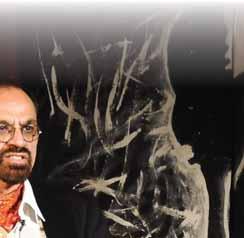

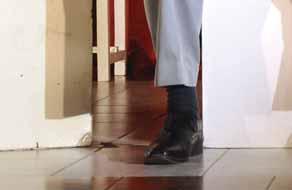
a rigorous three-month exposure to theatre methodology, culminating in a performance. The workshop has been held at RCB premises for three years with some places reserved for participants from The Rotary Theatre Club. Rotarians have regularly taken part in major productions of BLT. There was also some original scripting for a short play called Wheels. It was about the need to rethink fundraising strategy in Rotary clubs — and to move on from mere charity to social development goals. The play was invited to perform in other clubs in Bengaluru.
Coming to the future of the theatre club, yes, a scaling up is definitely on
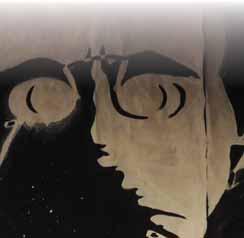
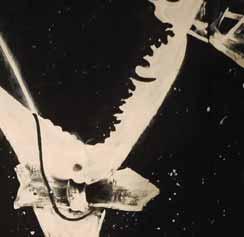
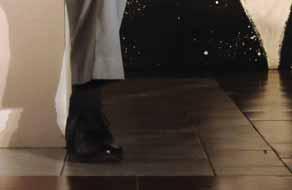

the cards. A major fundraising production was planned for 2020 in collaboration with BLT. It had to be put off because of the Covid pandemic. There are other ideas and plans, which will take their own time to take shape. For instance, the idea of creating a Theatre Fellowship across Rotary clubs, both within India and internationally. I have been in touch with the Rotary Club of Roswell (in Atlanta) which has a longterm association with Georgia Ensemble Theatre, very much like that of BLT and RCB. Another plan is to play a catalyst role to promote serious theatre activity in Rotary clubs in and around Bangalore. A third is a more ambitious idea, a Theatre-for-Peace programme across Rotary clubs. The recent dialogue between Rotary clubs of India and Pakistan revealed the potential for more ground level projects.
Can you give us a peek into future programmes of BLT?
Well, BLT is 60 now, celebrating its diamond jubilee. There are plans to include Tagore’s 160th birth anniversary year (2021) into the celebrations. There are two original adaptations of Tagore’s works ready for staging. And there is the internationally acclaimed
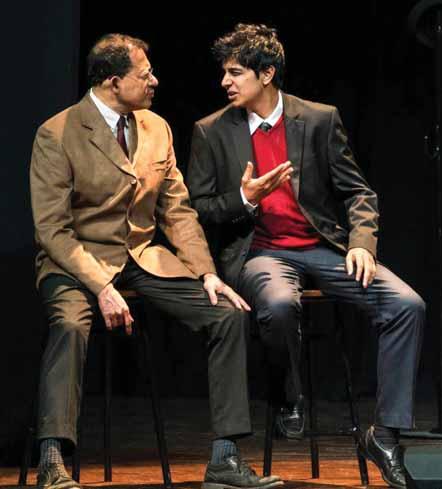
The theatre has still not acquired included in the curriculum in schools and colleges. One problem not fully addressed (or even recognised) is the sustainability of theatre programmes.
play based on the Gandhi-Tagore exchanges, The Prophet and the Poet, with 110 performances done already. I am personally involved in a project to develop a play based on exchanges between the founding fathers of American independence and the court of Hyder Ali and Tipu Sultan. The true strength of BLT is in its investment in long term theatre development programmes that actually sustain the performance programme.
In your opinion, what is the scenario when it comes to English theatre in India, and its future?
English language theatre is an incongruity in a country in which only two
percent of the population speaks the language. Neither I nor my writing can truly represent the vastness of Indian theatre. Much of that vastness is facing extinction. And yet English language theatre will certainly flourish and grow in India. Although it caters to a small minority in the population, it is a most influential market segment in society. This has been so for a very long time indeed, and is going to remain so. The people in this segment have access to vast resources and the power to influence policy at many levels. So, English language theatre can be expected to grow in India. There is more interest in writing for the stage now than 20 years ago. BLT itself is publishing at
least nine volumes of plays developed over the years. The first three volumes were released just before the pandemic struck. The rest should be out early 2021.
Is the younger generation interested in theatre?
Much more now than a few years ago. But pursued more as “been there, done that”, rather than as a serious quest. The theatre has still not acquired sufficient societal status to be included in the curriculum in schools and colleges. There are exceptions, of course. But the number is very small. One problem not fully addressed (or even recognised) is the sustainability of theatre programmes. More specifically, where are the teachers? I mean qualified teachers. If amateur theatre artists take to training and teaching, we can only produce amateur artists.
How has the pandemic affected the theatre scene? Have you organised or are planning virtual screening of plays similar to movies on OTT
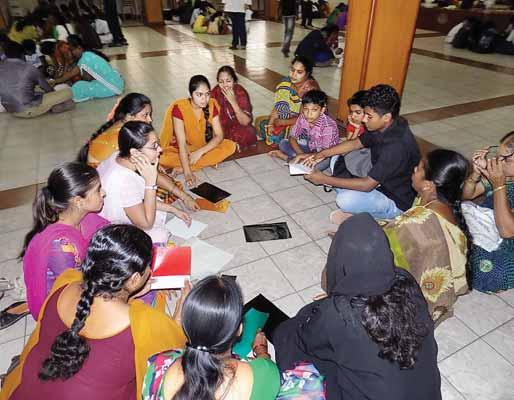
Below: Rotarians performing Emil’s Enemies, a play on Dietrich Bonhoeffer and the last assassination attempt on Hitler.
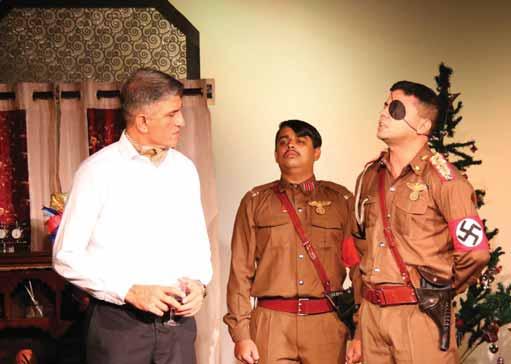
or Carnatic music ticketed performances done online as in Chennai? In BLT we have done our bit of innovation in online performances. We have even explored low cost (but good quality) pre-recorded performances that can be presented online. There is a long term programme called Courtyard Theatre. These are successful play scripts converted into a twoactor format, performed with minimal staging requirements. The most recent of these has been Shakespeare By Any Other Name. It is a play on the idea of Shakespeare and how he got to be the god-like figure in theatre. It has two women performing. Like all plays in the Courtyard programme, this Shakespeare play is also designed to be performed in a wide variety of venues. But in the Rotary Theatre Club, it has been a period of lull, restricted to play readings.
Designed by N Krishnamurthy


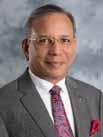

Dear district governors,

In these difficult days, we are so heartened to receive such uplifting reports on the unrelenting efforts of our Rotary members who have responded in their communities against the Covid-19 pandemic.
Today, the single question we hear time and again as we traverse the virtual world is, “Are we getting involved with Covid vaccination?” Considering the success and expertise we have gained in our polio eradication effort, this question is both natural and timely.
The answer is yes. We will have an important role in the months ahead.
This does not mean we will deviate in any way from our avowed commitment to eradicating polio, which remains our highest priority and will continue to be our only corporate programme. Polio vaccinations and surveillance activities must continue unabated, as must our effort to raise $50 million per year for this effort.
But as we know, there is a pandemic sweeping the world. The Board of RI and the Trustees of our Foundation met in joint session and have agreed that we have a role to play.
We ask you, then, to encourage your clubs to:
Utilise Rotary’s knowledge of vaccine safety and efficacy based on our polio eradication experience to conduct vaccination education and communication outreach in your communities. This will need to be tailored to local contexts to address unique cultural and regional needs. Your leadership will be critical in crafting the appropriate messages and strategies.

Engage, where appropriate, with our current polio eradication partners WHO and UNICEF at the country level to offer Rotary’s support to Covid-19 response activities, including vaccination efforts.
Partner at the local level with governments, corporations and foundations to support Rotary activities at the country level.

Through hundreds of global grants and projects, Rotary members have demonstrated what we can accomplish to raise awareness, deliver critical personal protection equipment and provide support for frontline health workers. As you learn of work being done in your area, please encourage clubs to add to the more than 3,000 projects already registered on Rotary Showcase (please log in to My Rotary first, and navigate to Rotary Showcase). We would like to know about them.
We have one final call to action: Help us combat the powerful, growing force of vaccine resistance and misinformation. Our advocacy in our communities will be critical — we need to spread the message about the power of vaccines to save lives.
Working together, we have done so much to adapt to the Covid-19 pandemic, to care for our communities and to prepare Rotarians for the work ahead.
We do this for ourselves and for future generations. We do this as part of our obligation to support our world as it faces the most significant challenge of this generation.
Thank you.
Holger Knaack RI President


K R Ravindran TRF Chair

Rasheeda Bhagat
On a gloomy monsoon morning in Mumbai, when the skies had opened up, a worried Gurpreet Singh Uppal, president of the Rotary Club of Bombay Mahakali Heights, RID 3141, looked up at the sky from his balcony, to find that it was indeed raining
heavily. “We had planned a small event to hand over some material for vanwasi (tribal) girls which we had collected after putting in a lot of hard work for a stretch of two weeks,” he recalls.
It was simple but heartwarming project conceived by Kiran Srivastava, the club’s director for
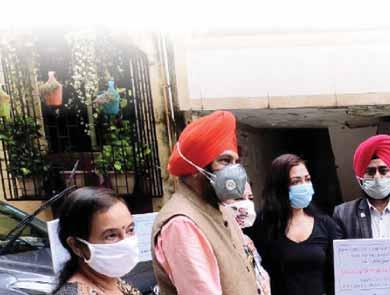
community services, and the beneficiaries were little tribal girls of Mangaon village in Raigad district, about 180km from Mumbai. When she heard about the plight of these little girls of Mangaon, and the abject poverty under which they lived, she was very moved and planned this project,” says Uppal.
(L to R): RC Bombay Mahakali Heights community services director Kiran Srivastava, Satinderpal Ahluwalia, Pinkky Rajgarhiya from the Chingari Foundation, club president Gurpreet Singh Uppal, DG Sunnil Mehra, project coordinator Dr Manish Motwani and Verinder Kaur Uppal with the materials collected for the underprivileged girls.
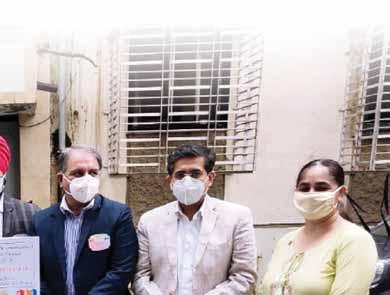
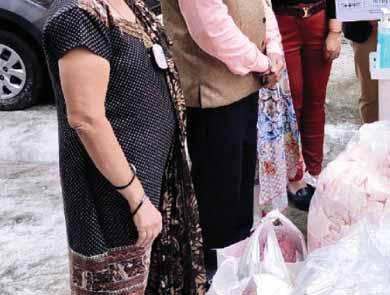
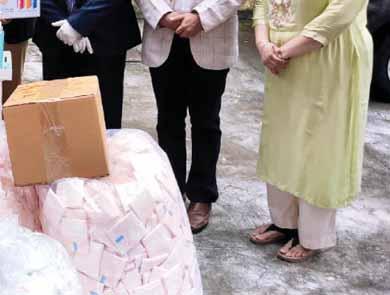

He explains the club identified this project as it works very closely with the NGO called the Chingari Shakti Foundation. This NGO not only focuses on the wellbeing and empowerment of the
girl child, but also runs a school for specially-abled children. The girls who needed the Rotarians’ help live with their families which are so poor that they cannot afford to provide simple items to their
Money started pouring in and in no time at all — actually barely 2–3 days — we were ready with more than the funds required for the project.
Gurpreet Singh Uppal club president
daughters for everyday use that all of us simply take for granted… such as talcum powder, hair oil, sanitary pads and undergarments. “The families simply do not have the resources to give them proper clothes and the girls often have to share boys’ undergarments as these cannot be bought separately by the parents for them.”
After learning about this need, an immediate meeting of the club’s board was convened, the project discussed and a fund collection campaign was planned
with voluntary contributions from members. “Money started pouring in and in no time at all — actually barely 2–3 days — we were ready with more than the funds required for the project. It took only one of our members to raise over 70 per cent of the funds needed,” he adds. The amount was only `50,000 but the project was so heartwarming, and the items so badly required, that the Rotarians realised the urgent need for implementation.
Braving the rain, the club president and his wife headed to a past president’s house where the distribution event was planned and attended by Pinkky Rajgarhiya who runs this award winning NGO.
Under the leadership of RID 3141 DG Sunnil Mehra and chief coordinator Manish Motwani, the meeting started. Apart from pledging the club’s support to the Chingari Foundation for more such admirable causes, Pinkky was also bestowed an honorary membership of the club.
The Rotarians handed over for the tribal girls 500 face masks, five sanitiser stands, an adequate number of sanitiser bottles, 9,500 sanitary pads and 230 sets of undergarments to the NGO and its volunteers have reached these packages to the tribal girls.

This meeting shows the real strength of Rotary e-clubs. Thanks to the pandemic, today all our Rotary clubs are functioning like e-clubs. But for all of you this is nothing new. You have been meeting like this all along,” said RI President Holger Knaack, addressing the Global meet of E-clubs hosted recently by Rotary E-club of Chennai, RID 3232.


The participation were 80 e-clubs from 28 countries across six continents. “It looks like a Rotary convention of e-clubs. We missed out Antarctica because there is no Rotary club there,” said PDG Raja Seenivasan, mentor for the host club.
“Susanne and I are happy to join you this morning or afternoon or



evening,” said Knaack, acknowledging the different time zones across which the Rotarians had logged in. “I chose the theme — Rotary opens opportunities — because it works at various levels. We are gifting an opportunity to people when we give them eye glasses or wheel chairs or micro credit. Rotary is also opening opportunities for us — for a richer, more meaningful life and for me, Rotary has broadened my view and given me several friends. It is also about personal growth. It means becoming a better leader,” he said.
doing extraordinary work helping people survive this pandemic. Cherish all these virtual experiences you are learning now because this is truly a great step for Rotary,” he added.
The RI Board has also adapted well to the pandemic challenge. “We are meeting every second month, sometimes every month. This is more effective and definitely inexpensive. RI will have

This year, more than ever Rotary has opened opportunities to its members to look at various ways to reach out to people. “You are

Cherish all these virtual experiences you are learning now because this is truly a great step for Rotary Holger
Knaack RI President

many more such virtual meetings in the future.”
Recalling his visit to Chennai in 2013 when 12,000 Rotaractors had gathered to create a highfive Guinness record, Knaack noted that RID 3232 “has the largest number of Rotaractors — 25,000 in just one district! But we need to attract them to Rotary. Think of newer club models that will fit the needs of
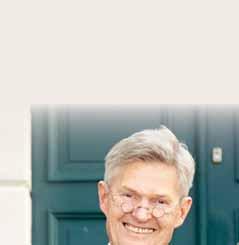
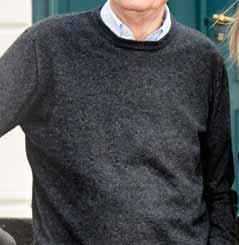




younger professionals. One major problem in Europe, Australia and Japan is the increasing age in Rotary.”

To a question from an e-club member in South Greece about getting data from RI about Rotarians who have left Rotary, so that they can be invited to join an e-club, the president said, “we cannot share much data because of Rotary’s privacy policy. But you can reach out to your neighbouring clubs and ask them personally for their members who have left the club.”

Another member from Italy wanted to know Rotary’s plans for handling Covid vaccine when it
arrives and Knaack said that the infrastructure used for polio immunisation could be also used for Covid vaccination. “We have learnt great lessons from polio. We did a wonderful job then and we can do a great one now.” he said.


RI President Holger Knaack and his wife Susanne.



partners of RI directors to get involved in Rotary. Holger, a director then, floated the idea of chartering an e-club to cater to younger people and those who could not afford to meet over lunch. We formed our club in Dec 2014 and it has been a wonderful experience ever since,” she said.
Rotary started the that this could be a futuristic model.
V Raja Seenivasan past district governor


A special Hello Holger session had the presidents of all 80 clubs greeting and waving to the RI president and his wife Susanne, one after the other. “We had several rehearsals for this session,” said event chair Jayanthi Raja Seenivasan, talking to Rotary News about some of the behindthe-scene moments. “It was a fun experience. Thankfully, we did not face any technical glitches. We had to coordinate with Rotarians from various time zones and they all cooperated so well,” she said, making special mention of an Australian e-club member who “would log into our rehearsal on zoom meet at 1 a m (Australian time) and doze off. He would wake up when his name was called out, say ‘Hello Holger’ and go back to sleep!”
“This is the first time I saw so many e-clubs saying hello to Susanne and I,” smiled Knaack.
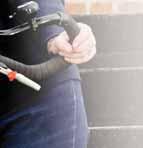

She has been part of Rotary since 1996 “when we opened our home to two 16-year-old boys from Slovakia and Switzerland under the RYE programme.” The couple has hosted 40 youth exchange students at their home until 2013 when Knaack became RI director.
She regaled the audience with anecdotes on how she met Holger. “Both of us went to the same college. He claims to have seen me on the first student assembly. I don’t remember doing that, for, at that time we were just three women against 94 men! “

Susanne is member of Rotary E-club Hamburg Connect, Germany. “I enjoy my membership here. When Gary Huang became RI president in 2014, he urged the


PDG Seenivasan said, “Rotary started the first e-club in 2002 — Rotary E-club One, USA — with a foresight that this could be a futuristic model. But most people did not realise the potential of e-clubs till the Covid pandemic. And now we all have started functioning through e-meetings, including our Hawaii convention. This meet will highlight the potential of e-clubs in attracting new members.”

As DG in 2013 he had chartered the Rotary E-club of Chennai. In July this year RIPE Shekhar Mehta inducted 11 members from different countries to this club in just a day, he said. DG Muthupalaniappan congratulated host club president Devaprasad for putting together “this unique and novel global meet of e-clubs. Technology has been an enabler. With this pandemic, traditional Rotary clubs have also taken to virtual meetings. In the long run, this is going to help grow Rotary.” He spoke about the district project Orange which will address avoidable blindness throughout India, starting with Chennai, where 104 vision care centres will be set up. TRF has approved seven grants worth $1.7 million for this project, he added. Host club secretary Shravan Balamurugan delivered a vote of thanks.
Rasheeda Bhagat
It was colours galore and celebration of nature at its best at the Global Greens photo contest organised by the Interactors of RID 3040, led by its DIR Avhaan Narang. The contest was organised in partnership with Saevus magazine, that is devoted to environmental conservation.
Many of the pictures taken by these youngsters
were of great quality, and as Narang put it, there is immense joy in pursuing “photography which is the ultimate art where you capture a moment of beauty through your camera and then save it for generations.”
Addressing the meet, RID 3040 DG Gajendra Narang said the contest got an impressive number of
160 entries from Interac tors all over the world.
“A dedicated team of jury from Saevus, led by its managing partner Sandeep Mal, a Rotarian from the district, selected the best three pictures for awards, and five honourable mentions.
He also thanked Sree Nandy, CEO of Saevus magazine, who is a Rotarian for becoming the
knowledge partner for this event of the Interact clubs of his district.
In response Sree Nandy said this had been a rewarding experience for them too and promised that “in the future too we will be happy to work with Rotary to reach the message of the urgent need to protect the environment to the youth of this country.”

Mal said the quality of the photographs submitted for the contest was “really wonderful” and the pictures had to be shortlisted through several stages. The first prize went to Aditya Krishna Menon, for his brilliant black and white photograph of a dragonfly trapped in the web of a spider.
Describing the moment he captured that prize winning entry, Menon said, “I was sitting at home, bored by the lockdown, and saw both the spider in its web
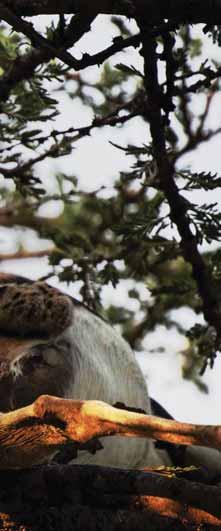
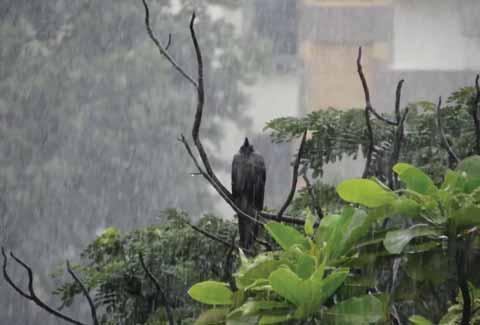
Rotary News Editor Rasheeda Bhagat explained that taking a good picture is more about the eye behind the camera, than the camera itself. While today anybody can take a good picture with a mobile phone, those who were interested in serious photography should make it a point to use cameras. Apart from composition and understanding the importance of light and its source, patience is of great importance, particularly while photographing nature and wildlife. Recalling the importance that Life magazine of yesteryears gave to photographs which it carried over full pages, she urged the Interactors to look up the pictures published by the magazine, which captured the mystery, magic, essence and beauty of the subject in the pictures it carried.
Talking about the great photographer Henri Cartier-Bresson, who was
present at the Birla House a day before Gandhiji’s assassination, she explained his concept of the “decisive moment” of a photograph. A professional photographer has to be always alert and sharp, and sports photographers know this best. If they blink even for a second, they could miss the picture of the match!
Reiterating the importance of patience, she said that while photographing a stunning sunset, most people pack up their camera kits once the sun has set. “But the real magic in the evening sky begins after the sun has set. The sky rapidly changes colours and pictures shot of the glowing sky after the sun has set can be very dramatic and rewarding,” she added, and urged the young photographers to never give up their passion for this hobby, which could well turn into a meaningful profession, if they pursued it.
and the dragonfly on the ceiling. As the web was brightened by the light, I saw the dragonfly getting attracted by the light and it started moving towards the spider’s web. I knew that sooner or later it will get caught in the web, so I quickly grabbed my camera and waited.”
The picture, shot with a DSLR camera, and published here, has brilliantly caught the delicate web, the hunter (spider) and the victim (dragonfly).
It was heartening to know that the prize-winning youngsters have all used cameras, and not their mobile phones, to compose great pictures. It shows their serious interest in photography as a hobby, and maybe later, as a profession.
But my favourite from the prizewinning lot at the event, over which I presided, was the second prize winner Vishal Naveen’s picture of a monkey with
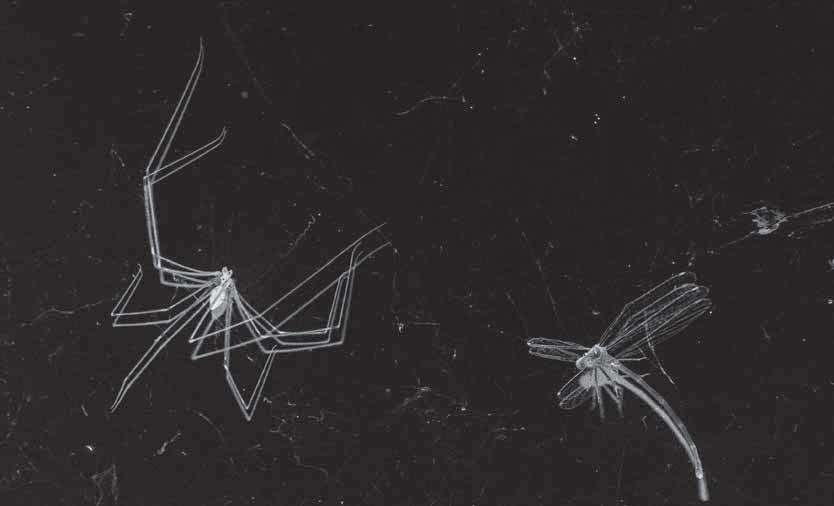
its little one, which has made it to the cover of our January issue. To me that picture speaks so much… of course its composition, its sharpness, the back lighting, and other technical features are great. But it also proves the adage that one picture is worth 1,000 words.
The perfect picture
But first Naveen’s take on how he took the picture: “It was outside the Guindy
The prize winning photo of a spider going for its kill, a dragonfly.
Park in Chennai and I saw many monkeys and among them this mother and child, and took a few pictures. But I wasn’t satisfied with the shots, so I waited for the sun to set, and when I felt the light was perfect, I took this picture.”
The picture has wonderful backlight and the frame is perfect too. But the emotions it is bound to create in the viewer, and that too when such a disastrous year like 2020
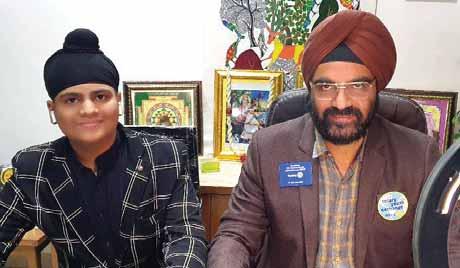
is over, and a new year is beginning, are bound to be overwhelming. This picture is about both love and tenderness as well as hope and protection.
PDG Pramod Jhejhurikar, who addressed the event, congratulated DRR Avhaan Narang for “this wonderful initiative that has connected Interact clubs all over the world.” He recalled that a few weeks ago, Rotary India had organised a wildlife event for school children addressed by RIPE Shekhar Mehta which had seen a record participation of 95,000, including thousands watching it through a Facebook link.
Lokesh Jhavar, District chair for Interact, announced that 10 Interact clubs were being opened within a week, to add to the 14 active Interact clubs it has now.
DGE Mahendra Mishra, project chair of this event, DGN Dhirendra Jain and District trainer Atul Gargav participated.
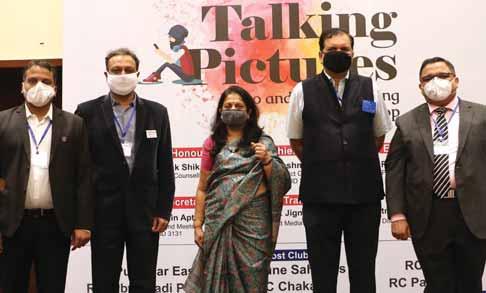
Inever thought that I would be able to create such fantastic videos myself. Very exciting!
“Creating good posters and videos to promote Rotary is the need of the hour, and now we know how to do it!”
“It was exciting to attend the first physical event of this year.”
These are some of the reactions received from the participants of Talking Pictures, the training event organised by the public image team of Rotary District 3131, says Mohan Chaubal, co-chair, public image. The event held in Pune aimed to equip the public image teams and leaders of Rotary clubs to create high quality promotional videos and posters about their projects and events. DG Rashmi
Kulkarni and the district PI director Vivek Dixit strongly believe in the importance of publicising such information for membership development and fundraising. The district PI team of 2020–21 is aggressively using digital media this year and has created several interesting videos, posters, brochures and hoardings to promote district projects and events.
It was soon realised by the PI team that the clubs wanted to create effective communication tools, but many of them lacked the knowledge to do so. So a workshop to train club officers on creating effective posters and videos was organised and got enthusiastic response, and participants for the hall capacity of 100 were registered within days.
“Jignesh Pandya, an expert in digital media and the backbone of the district’s digital media initiatives, was the trainer, and along with his team, did a great job of training the participants, including those who are not very tech-savvy, and captured both their interest and active participation,” said PDG Deepak Shikarpur, RPIC Zone 7. “Everyone was just glued to their phones for two and a half hours. No surprise that the participants found the training very interesting, insightful, and motivating,” added Chaubal.
Talking Pictures was launched by DG Rashmi, and PDG Shikarpur was the keynote speaker. District officers Manjoo Phadke, Shital Shah, and Sudin Apte shared their thoughts on the importance of effective promotion of Rotary. Rasheeda Bhagat, Editor of Rotary News , and Jyoti Rai, Senior Coordinator - Communications & Public Relations at Rotary International South Asia Office, shared video messages on the art of taking photographs and effective communication. The district’s digital marketing platform was also launched by Shikarpur during the event.
This event was organised, taking all mandatory precautions on safety during the Covid pandemic, under the leadership of Vivek Dixit and Mukesh Gupta.

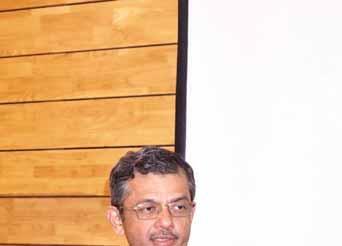

Jaishree
Change does not begin from somewhere or somebody. It has to begin with ourself,” said RID Bharat Pandya, addressing 400 participants from across the world in a virtual meet on ‘Be the change’ organised by the Rotary International Women’s (RIW) group.
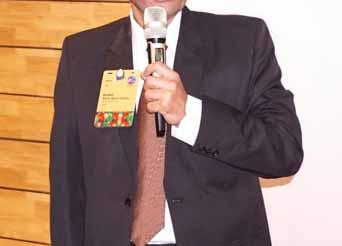

“Commitment, competence, courage and self-confidence should be your watchwords if you want to move with the change. It is better to embrace change, otherwise it will break or destroy you,” he added.
Rotary is at a crossroads now. “We are proud of the many great achievements done in the past. But much more needs to be done for a glorious tomorrow. The potential that each one of us has and the way we realise that potential, makes us successful,” he said.


Most positions in Rotary are for one year. “Are we adapting to change because of this tradition? Or are we really looking for a change?” he wondered, adding, “we have settled into a comfort zone, and complacency has set in. For long, our membership was stagnant at 1.2 million Rotarians. But in the last two years we are down to 1.18 million.” That is, even before the pandemic, the membership has declined. “Now is the time to look within ourselves and effect a change to set Rotary in the right direction.”
Pandya quoted Rotary founder Paul Harris’s words: ‘Rotary has to be evolutionary at all times and revolutionary on occasions,’ and cited instances where Rotary leaders have made revolutionary changes. “In these 115 years, from just four members in 1905 to 1.2 million now, it has always been



evolutionary and relevant to communities.” Rotary was started for fellowship and networking. The aspect of service was a paradigm shift and “today our motto is ‘service above self”. This is indeed a revolutionary change.”
When Arch Klumph set up the Rotary Foundation with $50, it was a revolution at that time and now, it is one of the foremost foundations in the world. So was the drafting of the four avenues of service and the fourway test by Herbert Taylor which is the yardstick for all Rotarians to live by. The CoL, Rotary’s parliament, was a revolutionary change at that time. “Now it is time to rework the policy. Do we need to wait three years to meet at the CoL to change the rules and policies? The recent introduction of the Council of Resolutions which meets every year is a revolution in that direction,” he explained.
Referring to TRF grants, he said, “Can you imagine anywhere in the world where your $1 can be matched multiple times?” This concept was revolutionary at that time. And, the newest revolution of Rotary is its action plan and the new vision statement. “Rotary’s future vision programme is another excellent revolutionary programme that has taken grants to the next level. It has shown Rotarians to act locally and think globally,” he added.

District grants help to meet local needs, while global grants help to create impactful projects in communities. “So let us not limit ourselves to distributing notebooks and school uniforms. Let’s dream big. The way forward is partnerships — working with governments, semi-governments and private organisations to increase our impact.”
PolioPlus is the best example for partnership. “However much we raise our collars and say we achieved it, we have to realise that the polio success story would not be possible without
the partnership of world governments, WHO, UNICEF and the Gates Foundation.” Talking about expanding Rotary’s reach, he emphasised on the ‘Grow Rotary’ initiative which was adopted by RI in 2019–20. “Rotary is not a service organisation, it is a member organisation. Our members are our customers. We have to create value for our members, such as fellowship, internationality of Rotary, pride, self-development and leadership. Only then Rotary can grow.”
Talking about attracting ‘quality members’, Pandya said, “when you point a finger at someone, remember three fingers point at you. Rotarians must make an audit of their own qualities first. Then automatically your clubs will attract quality members.” He reiterated that there should be equal opportunities for men and women members. “RI has recently set a goal that by 2023 Rotary should have 30 per cent women in leadership positions.”
Women have been discriminated against for generations. “We need to change that outlook,” he said and referred to a medical study that compared the time taken by men and women in reaching a hospital after the onset of chest pain. “For males, the average time taken is two hours, while women reach out for medical help after 22 hours. This is because women ignore their personal problems,
wanting to put their family first. This change in mindset should start from you,” he said, addressing the women participants.
Change is needed in the public image of Rotary. “It is not about the public image to the outside world but to our members. At least 60 per cent Rotarians are not aware of what Rotary is. We need to market Rotary to the Rotarians first. We must take pride in our organisation. Only then we can market Rotary to outsiders.”
Signifying the relevance of Project Positive Health, Pandya suggested a shift in focus from curative to preventive healthcare. The corona pandemic has taught us two important lessons — good health is a person’s greatest wealth and the death rate in people with comorbidities is high, he said.
To a question from a participant about Rotary’s focus after polio, he replied that until polio is totally eradicated, Rotary will not consider any other major programme. “I believe, what is actually needed after polio is regionalisation. Different regions need different focus. What is a necessity in Spain, need not be so in another country. So, Rotary should be tweaked to meet the needs of different regions.”
At least 60 per cent
Rotarians are not aware of what Rotary is. We need to market Rotary to the pride in our organisation.
Denise Kilschan, an RIW member from RC Ibiza, Spain, suggested that Rotary can adopt menstrual health and hygiene (MHH) as a global project. RIW is awaiting RI’s approval for a Rotary Action Group for MHH. The RI director applauded the group’s initiative, saying, “Period poverty is as much a western issue as a developing country’s issue. More power to you.”
He suggested including Project Positive Health in the RAG as “women are as much susceptible to lifestyle diseases as men.”
RIW’s founding members Vidya Srinivasan delivered the welcome address and B Dakshayani delivered a vote of thanks.
V Muthukumaran
milk to households and my income has multiplied beyond my wildest dreams,” she explains.
Dark clouds of uncertainty and fear gripped Rathinam (60) at Kaatur village near Rasipuram, Namakkal district of Tamil Nadu, after she lost her only source of livelihood, an unskilled job, during the pandemic. “At my age, nobody will hire me to do any farm work. When I was terribly worried, it was the hand of providence and Rotarians who gave me this pregnant cow which delivered a healthy calf. I now deliver 10–12 litres of
Another heartwarming story comes from Padmavathi (38) from Masakalipatti village who never stops praising Rotary for giving her a healthy, pregnant cow. “My family is overjoyed and we will develop this gift into a big dairy farm. Thanks to Rotary, we have come out of poverty and looking forward to expand our milk business,” she smiles.
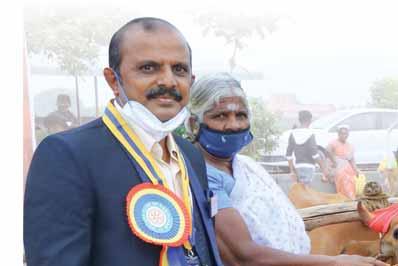
To celebrate 100 years of Rotary in India, RC Rasipuram, RID 2982, donated 108 pregnant cows to women living below the poverty line through a global grant project valued at `53.68 lakh, done jointly with RC Campo Mourao, Brazil, RID 4630, as its partner. While the project was conceived last year during the tenure of IPP A Thirumoorthi (known in the club as Ravi), the beneficiaries received their milch cows in a gala event presided over by club president

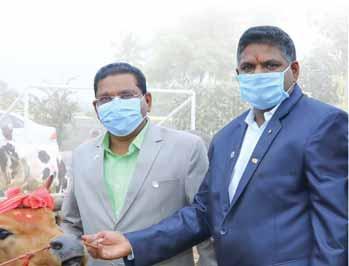
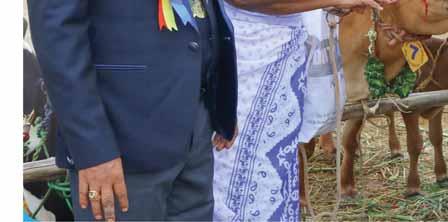

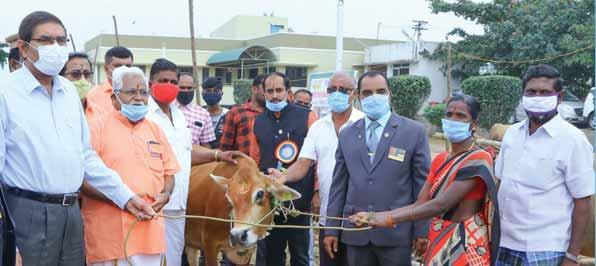
S Kathiresan, with district collector K Megraj as chief guest.
Earlier, a six-member GG team of the club had toured 8–9 villages to do a community assessment need and “find out what the people really need to earn a sustainable income. We got guidance and help from VAOs and self-help groups,” said Rtn N P Ramaswamy, secondary contact of the Kamadhenu Cow Project.
“We asked them specifically about their basic requirements and put forth suggestions for honing their vocational skills like tailoring. But they rejected that idea, and sought help for purchasing milch cows,” he said. The survey team chose the beneficiaries, mostly widows and women above 30 years, hailing from impoverished families after verifying their social background.
The club arranged a four-day training programme for the chosen beneficiaries conducted by three professors from the Veterinary College and Research Institute, Namakkal. “Dairy farming and financial literacy were taught to them, along with practical training at the veterinary lab of the institute, which covered aspects like processing
the value-added milk products and selling them either directly or through Aavin society and private vendors,” said Ramaswamy. A woman can earn up to `13,000–14,000 per month by rearing a cow, he estimates, adding that she will have to invest only three hours a day for taking care of the bovine.
Around seven years ago, the club donated goats by rotation to 150 poor women living at 7–8 villages near Rasipuram taluk with cash raised through members’ contributions. Following a commendation report by university officials, “the government took up the project with its own funding.” The cow donations have created a goodwill and “lifted the public image of Rotary in the nearby villages as our project gave a reliable source of livelihood to underprivileged families,” says Kathiresan. “We are double-happy as the Kamadhenu Project, our maiden global grant, was implemented on the silver jubilee year of our club.”
The global grant was sanctioned by TRF only after ascertaining various aspects such as the mode of selection of beneficiaries, their training and revenue yield. “This was a pioneering
project in this region,” says IPDG A K Natesan. “It took 12 months to get the project sanctioned, for initially there were doubts about its sustainability in the long run.”
Noteworthy projects
Since 2005, the club has facilitated 117 free heart surgeries, mostly on poor children, with its member S Balaji tying up with private hospitals. In another initiative, the club will be constructing a toilet for girls, set up a computer lab, RO water purifier and provide desks and benches to the Sacred Heart HS School, along with other facilities.
The funding with be through a GG valued at `25 lakh which is under the process of approval, says Kathiresan. “This Happy Schools project benefitting 800 students will be completed well before June.”
DG K S Venkatesan, PDG
A K Natesan, ARRFCs S Vasu, Gopalakrishnan, RID 3000, DRFC K Babu, Veterinary College dean Dr B Mohan and Animal Husbandry regional joint director Dr V P Ponnuvel were at the event to mark the handover of livestock to the beneficiaries.

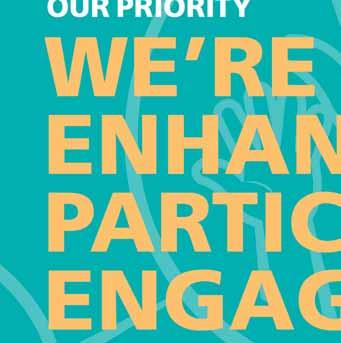
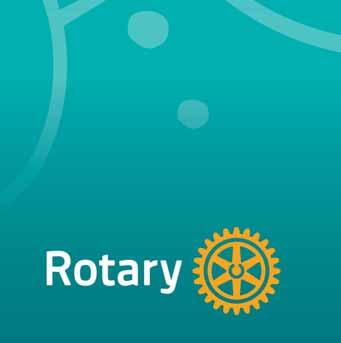



Putting our participants first.
We want all Rotary participants — our members and any others who connect through Rotary activities — to feel engaged and fuelled by their experience, whether they’ve been with us for one day or five decades. But we know that isn’t always happening. It’s time for us to take action.
Let’s ask our participants what they’re looking for in Rotary, and follow through with opportunities that provide value. That’s how we’ll keep people contributing and coming back for more.
What we will do.
Develop new ways to measure engagement and incentivise club improvement
Create new products and offerings that offer more and better value
Build leadership skills by working with other organisations like Toastmasters International
Offer new personal and professional engagement opportunities
What your club can do.
Seek Feedback from your Rotary participants and your community
Conduct A club “health check” and address gaps or issues
Adopt A more participant-centred approach
Find
New ways to include everyone in club activities and service projects



(4pm to 8pm)
15-16-17 JANUARY A VIRTUAL JOURNEY
ROTARY INSTITUTE 20-21 ZONES 4, 5, 6, 7
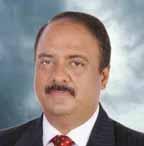
RIPE Shekhar Mehta
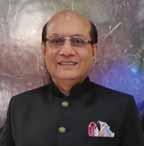


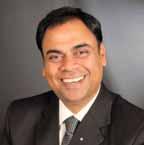
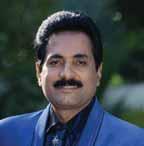
RID Kamal SanghviPDG Sanjay KhemkaPDG John Daniel
RI President ElectConvenorChairmanSecretary

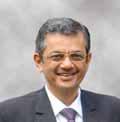
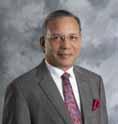
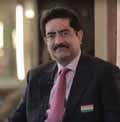
RIPN Jennifer JonesRID Bharat PandyaPRIP K R Ravindran Chair, TRF Kumar Mangalam Birla Chair Aditya Birla Group


Amitabh Kant
Chief Executive Officer –NITI Aayog of India
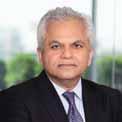
Vijay Advani

Nandan Nilekani Non-Executive Chairman of Infosys
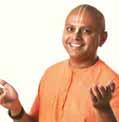
Executive Chair, Nuveen Gaur Gopaldasji
Motivational Speaker & Spritual Leader
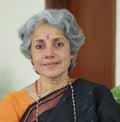

Soumya Swaminathan WHO, Chief Scientist
Nitin Nohria Dean, Harvard Business School
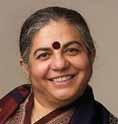


Dr. Yasmin Ali Haque UNICEF Country Representative
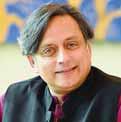
Shashi Tharoor MP

Vandana Shiva Scholar Sandeep Mathrani CEO, WeWork Sonu Sood Actor






Habil Khorakiwala
Founder Chair of Wockhardt Ltd

Kiran Mazumdar Shaw Chairperson, Biocon

Varun Sridhar CEO, Paytm

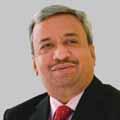
Pankaj Patel Chairman and Managing Director - Zydus Cadila Limited

Nasir Shaikh Atos Head of Human Resources: India
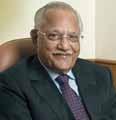
Dr Prathap C Reddy Founder Chair, Apollo Group of Hospitals

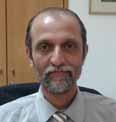
Ajit Ranade President & Chief EconomistAditya Birla Group

Philippe Mareine Chief Digital & Transformation Officer, Head of CSR at Atos, France

Bhupesh Daheria CEO, Aegis School of Data Science
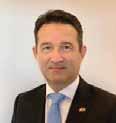
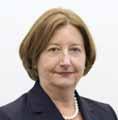
Arthur Mattli Swiss Ambassador Judge Silvia Fernandis Chair, Intl Criminal Law
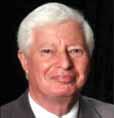

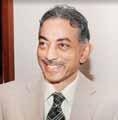
Vallabh Bhansali Thought Leader & Investment Banker
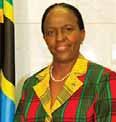
Liberata Mulamula Former Ambassador of Tanzania to USA and currently Secretary , Ministry of Foreign Affairs
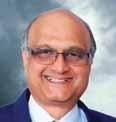
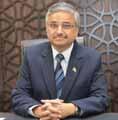
Dr Randeep Guleira Director -AIIMS, New Delhi
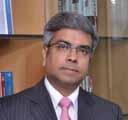
Vaswani CEO Barclays Bank
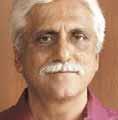
Ayaz Memon Consulting Editor and Columnist

Riddhima Pandey Climate Change Activist
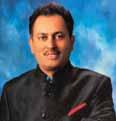
CEO,
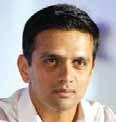
Dravid Former Captain, Indian National Cricket Team

PRID Bryn Styles Aide to President-Elect Rtn Shekhar Mehta
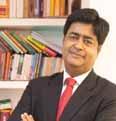
RID Peter KyleTrustee Larry LunsfordTrustee Gulam VahanvatyRIDE Mahesh KotbagiRIDE A S Venkatesh
RI DirectorChair – Rotary Peace Centres




Rasheeda Bhagat
was in finding out, from the women themselves, all about the torture and brutality they had suffered during the Taliban years and earlier.

n 2005, while working with the Hindu Business Line, I got an opportunity to visit and report from the war-ravaged Afghanistan. It had then been freed from the dark days of Taliban rule, its reconstruction was on, but the most heartbreaking part of the trip was watching the devastation of the entire country following decades of strife, violence, war and brutality. The women were of course the worst hit, and being most interested in gender issues, my first and foremost focus

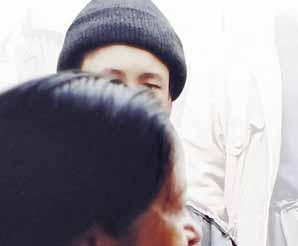
The trip happened following a casual chat with Uma and Karthik Narayanan, who had good friends in the French embassy in Kabul, who had promised to be our local guides. So Karthik and Uma, Narayanan, their friend from Bangalore Maya Jaypal, and I, set off on a flight from Delhi to Kabul. Our natural choice of hotel was the



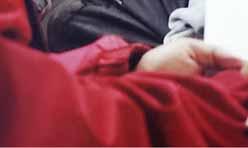
Intercontinental, which despite its terrifying history of being attacked and damaged in street warfare by different kinds of militias during the country’s civil war in the 1990s, sustaining periodic battering all the time, was the only option, being the only large decent hotel in Kabul with some assurance of security.


After 9/11, during the US invasion of Afghanistan, and its aftermath, it was here that the international media had mostly stayed. From the Kabul airport, as we drove to the hotel on roads which I then thought were broken and bruised — worse came later — it was impossible to miss the ubiquitous land cruisers, crisscrossing the roads. I later discovered that more than the Hamid Karzai government, international aid organisations, mainly those belonging to the United Nations, were running
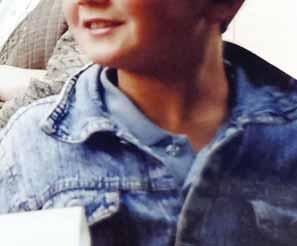
Interviewing some Afghan children.
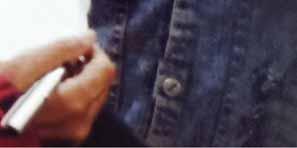
The most heart-breaking part of the trip was watching the devastation of the entire country following decades of strife, violence, war and brutality.
the country and these land cruisers belonged to the NGOs operating out of Afghanistan.
With no doubt in my mind that the status of women and girls’ education would form the backbone of the articles I file on Afghanistan, with great eagerness I accompanied my companions to Chicken Street, Kabul’s only famous and buzzing shopping street. With the fragrance of kebabs and other street foods wafting in the air, but alas for which we did not pause, as my friends were mostly vegetarian, the street was filled with shops overflowing with colourful ware such as different kinds of jewellery, leather goods, garments, knick-knacks, artwork, but above all, oriental, hand and machine-made carpets and rugs. Almost anything could be found carved from lapis lazuli, a semiprecious, deep blue gemstone native to Afghanistan… rings, ear rings, necklaces, bracelets, tableware, and so much
more. We had been advised to carry US dollars in the denomination of 1, and these came mighty handy for the shopping, which opened up conversations.
Naturally this street was a magnet that drew scores of foreign visitors on the lookout for Afghan exotica, about which they had read or seen in movies. But providing a stark contrast to the vibrant colours, shine and shimmer of the goods on Chicken Street, were the shadows clad in light blue, that were gliding down the street, like walking bundles of life.
Most of Kabul’s women had, after long years of Taliban rule, gone behind the blue burkha, and were completely covered from head to toe. It broke my heart to reflect that once these women were so well-known for their sense of style and fashion, that Europe’s leading beauty care brands would launch their new product trials in Kabul along with ones in Paris, London and New York, to get a sense of its popularity with women. I tried following and addressing a couple of
them, in a bid to make some conversation, but so scared were they of talking to a stranger, that the moment I tried to approach them, they quickened their pace and slithered away. Later I learnt they were still fearful of the Taliban.
As we do our rounds around Kabul, trying to meet as many people from NGOs, embassies, schools, civil society and women activists, I am introduced to Nishaan (name changed) who is trying to revive the Baghe Zanana (garden for women). During the Shah’s days, the women of Kabul had an exclusive, fragrant and vibrant garden to themselves named thus, where they could meet and relax. But after the Russian invasion, and particularly
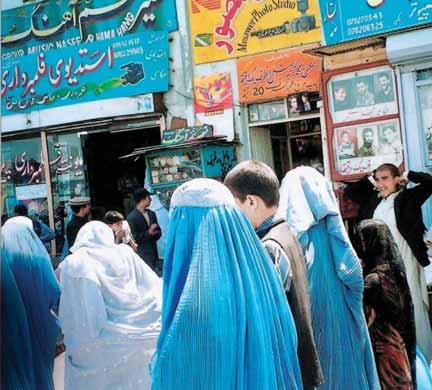
during the Taliban’s rule since 1995, as women were banished to their homes, the garden had fallen desolate and became a weed and insects-infested barren land. Thanks to the efforts of an NGO, this was now being renovated, and luckily for me, had been thrown open
to the women of the city barely a few months earlier. But the women came here only on Fridays in the afternoon.

Above: The Taliban had destroyed Afghan women’s confidence to such an extent that it was impossible to find a woman on Kabul’s streets willing to talk to a stranger.
As Friday was only a day away, I promptly went to the Baghe Zanana the next day, and could hardly believe my eyes. Here were at least a couple of hundred women, adolescent and younger girls; all of them had thrown away their burkhas, and there was stunning beauty, laughter and chatter on display. The women were seated in big circles, chatting with friends and enjoying a picnic lunch pulled out of baskets, as their children played in the park.
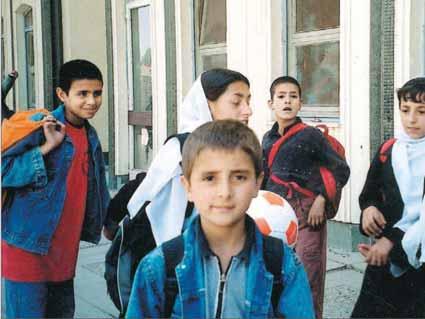

Every Friday a few hundred women and
children assembled here to let down their hair, and remind themselves that it had been over three years since their worst tormentors, the Taliban, had gone. The Taliban, in the name of religion, had devastated the lives of tens of thousands of women, deprived them of human dignity, forced them to don the burkha (known as chadri in Afghanistan), quit
their jobs and took their daughters out of schools and colleges. It was haram (forbidden) for a woman to step out of her house without being accompanied by a man, and women could not take any birth control measures.
All this was history now. Many educated and qualified women, who had braved nearly 15 years of conflict and violence under
Soviet occupation and the mujahideen regime, considered the Taliban’s obnoxious laws against women to be the last straw on the camel’s back, and had fled the country during the six-year Taliban rule, beginning 1995.
A very excited Nishaan told me that only a couple of months earlier, “we had special visitors at the Baghe Zanana — three
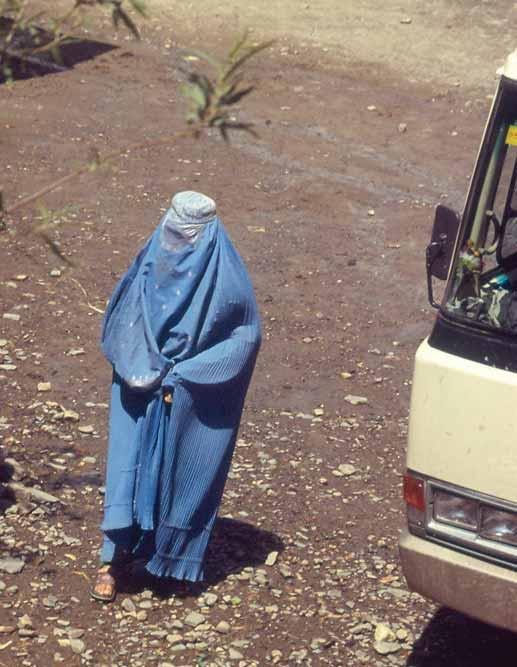
The women were seated in big circles, chatting with friends and enjoying a picnic lunch pulled out of baskets, as their children played in the park.
Afghan women doctors who had been living and working in Germany for almost a decade.” They had come to their home country to check out for themselves the situation on the ground. Prior to the visit to the garden, the doctors had taken a tour of Kabul’s dilapidated and ill-equipped hospitals, struggling to offer even minimal healthcare to the sick. They saw the pathetic state of the buildings, the inadequate infrastructure, outdated medical equipment and inadequate medicines, and above all, doctors from foreign countries, including Indian doctors, working against all the odds to save lives.
“When they saw so many women assembled in the women’s garden — women and children chattering, laughing, eating and even singing — they made an important decision. They took out their German passports and tore them to bits, saying
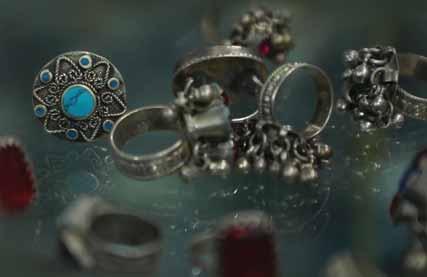
we are not going to leave Afghanistan. It needs us.”
With Afghanistan soon descending into chaos and violence again with the Taliban regrouping and resurfacing soon after my visit, and continuing to do so since then, I have often wondered if those brave women doctors regretted their decision. Anyway, even then, there were plenty of challenges facing the country.
Afghanistan is still “unstable”, said Carol Martin, programme director of the Swedish Committee for Afghanistan (SCA), which was established in 1980 as a humanitarian solidarity agency to support the Afghan people against Soviet occupation. It was the biggest international aid organisation working in Afghanistan’s 21 provinces, with an annual budget of
$22 million. She said there had been times in the last 20 years, “when the SCA has virtually taken over the role of the government in administering the country.”
She added that the reconstruction of Afghanistan would “take a long, long time, because this is a totally devastated country and there is no real law-making government here. This is what frustrates the Afghan people.”

The World Bank’s country chief in Afghanistan then, Jean Mazurelle, was more forthright about the fragile peace holding in Afghanistan. But first an amusing story he related to us. Of course, all foreigners in Afghanistan were on high alert, as risk of kidnapping was rampant. Once, a couple of World Bank’s men were waylaid near their living quarters,

and asked at gunpoint to “part with videos of porn! The Pashtuns waving a gun at their face said since they were “westerners, surely they watched porn movies all the time! My men had a hard time convincing them that they honestly did not have any porn videos,” he chuckled.
But, on a serious note, Mazurelle, who had been posted in Afghanistan for a year, felt that unless the Afghan government and the international community speeded up reconstruction efforts and make the change ‘visible’, the people’s patience would run out. He was incredulous and failed to “understand why the international community did not take care of this country much earlier. Why did we wait till the situation came to the point of the Taliban and the Soviet occupation before that? I can understand the resentment of the

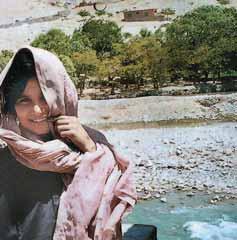
Afghans that they had to wait till 9/11 before the international community took notice of Afghanistan. An Afghan told me that 9/11 was a lottery ticket for them, and they would not give away this lottery ticket. I felt very sad to hear this but can understand their resentment against the entire world and why they want to be compensated.”
For me, the 10-day visit to Afghanistan was as heartbreaking as educative. I learnt that over the past 25 years, educated Afghans had fled the country, and three years after the ouster

of the Taliban regime, a small segment of them, such as the Afghan-German doctors mentioned above, had begun to return. But they had to accept the reality of earning a fraction of the money they used to make in Europe.
Majid Nabizada was one of them. He had returned from France, where he earned 2,200 euro a month, to work at the Lycee Esteqlal High School in the heart of Kabul. This was battered by decades of war but had now been rebuilt and was being run by the French. His present
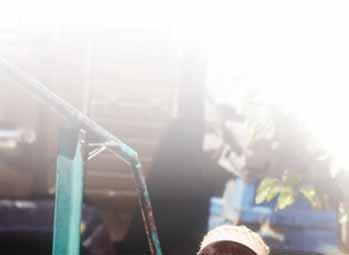


I don’t understand why the international community did not take care of Afghanistan much earlier. Why did we wait till the Taliban took over?
Jean Mazurelle World Bank chief in Afghanistan
salary was a meagre $60, and to pay his monthly rent of $250, along with a year’s rent in advance, he had to fall back upon his savings from his 22-year stay in France. But other local teachers I met at that school, did not have this luxury. I met one teacher who had to double up as a taxi driver to make both rent and food.
When this was the plight of the teachers, one felt like crying to even think about the wasted years for the students. Especially, the girls who were forced by the Taliban to quit study altogether.
Most of the country’s schools were destroyed by long years of violence and in interior Afghanistan classes were being held in dilapidated buildings without doors and windows, and sometimes not even a roof. What this would mean in a country with extreme winters and summers could be imagined. During its sixyear rule, the Taliban had banned girls’ education and closed all girls’ schools.
Director of the high school we visited, Wali Mohammed, explained
how the “Taliban destroyed our education system, forcing qualified teachers to flee the country.” It warmed your heart to see neatly dressed, bright-eyed young girls in the school library. But in this Islamic country co-education was rare and girls would have to leave this school, where 5,000 children received free education, after Class 3 to go to an exclusive girls’ school.
He added that while the younger girls had returned to school, those in their teens were reluctant to come back because they would now have classmates at least six years younger. I left the school wondering what the Afghan administration would do to get these young women back into mainstream education. Would any special classes be held for them?
There were more questions than answers in Afghanistan then.
(To be continued)
Designed by Krishnapratheesh S
Kiran Zehra
On its 41st charter day members of RC Mandvi, RID 3054, took a walk down memory lane to understand how well they have used the resources of The Rotary Foundation to do sustainable projects in this small coastal town in Kutch, Gujarat. “We wanted to see the impact we have created in our community by interacting with our beneficiaries of projects done so far,” says Darshana Shah, chairman of the charter day celebrations.
Among its milestone projects, the Rotary Colony in Godhra village, 17km from Mandvi, is a testimony to the club’s empathy for the underprivileged. Seventeen houses for homeless villagers were handed over with the support of TRF and 10 Japanese clubs in 2000. “Some of the beneficiaries have passed away and I was hesitant to talk to their family members who still live in these homes,” says Darshana. But the moment she made the phone
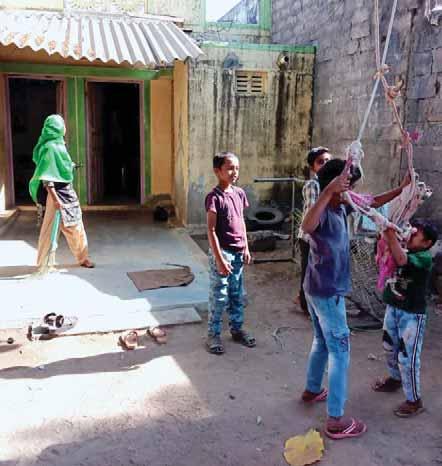
call, “I was greeted with respect and gratitude” from the other end.
“My father, a paan seller, could never have dreamt of owning a house. But thanks to RC Mandvi, we own a house now,” says 54-year-old Hasina whose late father Mohamed Ali Suleiman was a beneficiary of this lowcost housing project. She recalls talking to the project chairman Sandeep Shah asking him to enrol her father in the scheme. The global grant of Rs 7.36 lakh was to be used for construction of 15 homes but “our club built 17 homes, which survived the 2001 earthquake,” says Vinay Toprani who was part of the project. The 20x45 feet homes have two rooms, a kitchen, an underground water sump, a terrace, and piped water supply under the gram panchayat scheme. “This is more than enough to live a dignified life and is a blessing for our next generation as well,” says Hasina.
Dr Jay Mehta is a recipient of the Vimala Ramesh Shah Scholarship, named after the late club member. He practises medicine at the Trust Hospital and Bhartiya Hospital, Mandvi, and has been part of over 300 medical camps in the Kutch region. Recalling his admission to medical college in 2005, he says, “I scored 93 per cent in my Class 12 exams and was a city topper in science. But I was worried if I would be able to secure a seat for the BHMS course that I wanted to pursue.” His father who worked at a cloth store asked him not
to lose hope and apply for admission to the college.
A few days later he received a call from the school saying that the local Rotary club has come forward to give him a scholarship. “I got the seat on merit and also the scholarship worth `5,000 which covered my course fees and hostel charges,” smiles Dr Mehta. This scholarship, along with Rotary Club Mandvi Educational Awards, to students with good academic records from economically-weak families has benefitted many youth in and around Mandvi. “Since its inception in 1981, the club’s scholarships and awards have benefitted 350 students from Gujarati medium schools.
Landmark initiatives
The CJ Mehta Vaccination Centre, another landmark project, has immunised around 5,000 children against polio, hepatitis B, measles and other vaccine preventable diseases since 2003. The Dharamsey Nensey Rotary Community Centre, set up after the 2001 earthquake with funds from the Rotary Gujarat Earthquake Rebuild Trust and local donations, doubles up as a wedding hall for girls from
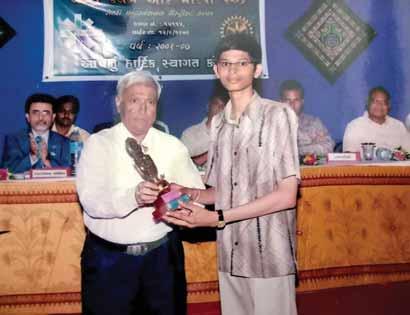
underprivileged families and is being rented out for local meetings, seminars, exhibitions and social gatherings.
Right in the heart of Mandvi is the Laxmiben Hansraj Latwala Bal Udhyan, a children’s park built and maintained by the club since 2002. Among other community projects, the club holds regular computer workshops for students, adult literacy
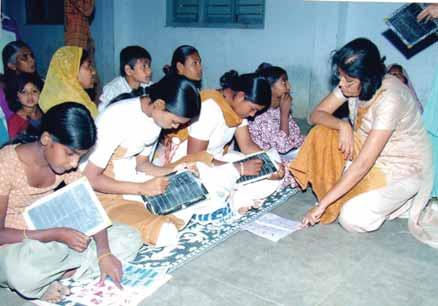
camps for tribal women and tree plantation drives in the region. “We may be a small club but we sure have made a big difference,” says Darshana.
A gender-segregated toilet block with handwash station was built at the Shamji Krishna Varma Primary School at a cost of Rs 85,000 which was mobilised through donations. “We should prepare our schools for the post-corona world where sanitation and hygiene will be top priority. Since this is a school for students from economically-weak backgrounds, the need for better sanitation facilities is more significant here,” says club president Pratik Shah. During the lockdown, the club members, along with Rotaractors, distributed food packets and masks to the homeless and sanitation kits to healthcare workers and police staff. “We are still distributing the masks and sanitisers to the public,” he adds.
Recently the club installed sanitiser dispensers at the local court, the Saraswati Shishu Mandir and the Sheth College in Mandvi.
V Muthukumaran
Rotarians across India are helping those afflicted by the coronavirus and many are doing so by using social media too. Here is a one example: Sandip Singh Walia from RC Green Land Silchar, RID 3240, noticed a message on his Whatsapp group from one Vijay Choudhary requesting a plasma donor to save his elderly father being treated at the QRG Health City in Faridabad.
One day later “I noticed that Choudhary was unable to find a plasma donor. And so I thought of helping him,” says Walia. He got the phone number of Jagdish Sahdev, president, RC Faridabad Central, RID 3011,
from the club’s website, narrated the situation to him and shared with him the patient’s details and Choudhary’s contact number.”
Jagdish then leveraged his Rotary contacts to get the concerned person to link with Choudhary. “Everything was lined up within an hour as Jagdish coordinated with the hospital management and urged them to update us on the patient’s status in regular intervals,” explains Walia.
“Vijay was extremely thankful to Rotary. A plasma unit was arranged by the local Red Cross chapter after Jagdish, an influential member of the plasma committee set up by the Faridabad Deputy Commissioner,
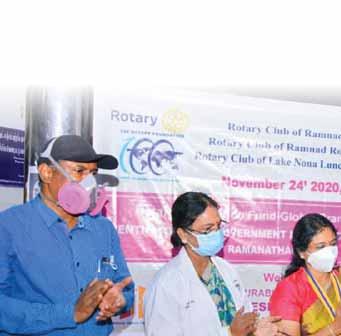
Ventilators being handed over to the Ramanathapuram Government Medical College Hospital.
arranging everything for the patient,” says Walia. This plasma unit is being kept “as a standby for emergency with the patient recovering at home,” he says.
In a major initiative, RCs Bagmati Kathmandu, Tripureswor, Kathmandu Metro, Kantipur and Kathmandu Downtown, RID 3292, jointly donated 400 visors, 20 boxes of disposable gloves and other safety material to the Patan Hospital, Lalitpur. PDG Chintamani Bhattarai handed over the safety kits to Dr Rabi Shakya, director, Patan Hospital. In his address, Bhattarai said he would bring in more support and material to the hospital for treating Covid patients and improving the existing infrastructure there.
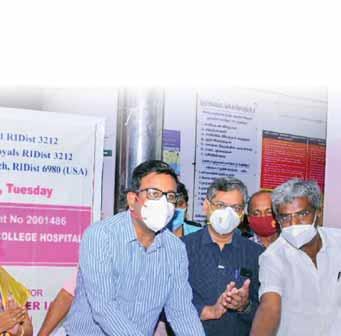


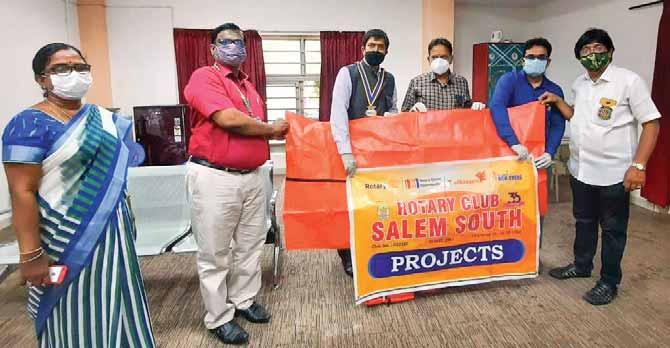
Project Aarogya
Covid immunity booster kits worth `1.1 lakh and over 50,000 masks were distributed to vulnerable groups including paramedics, conservancy workers and underprivileged people under Project Aarogya by Rotary Bangalore Brigades, RID 3190. The Covid care kit was conceptualised by club president Ashwani Kinger, club members Bindu Cherian and Samba Murthy. It contains two cotton masks, calcium and Vitamin
D3 tablets, Vit C tablets, paracetamol, sanitisers, liquid soap pack and guidelines in Kannada and English.
The club procures and distributes free medicines to health camps, PHCs, orphanages, old age homes and Rotary medical camps, says Kinger.
RC Bharuch, RID 3060 , has implemented a global grant project worth $42,143 to donate touch-free and handpump sanitiser dispensers, N95 masks, oximeter, electronic

thermometer, face shields and liquid sanitisers to hospitals, PHCs and police stations. PDG Ashok Kapadia, IPP Manish Poddar and club president Talkin Zamindar coordinated with their global partner RC Emory Druid Hills, US, for this mega project.
Covid crematorium
RC Ankleshwar, RID 3060, has set up a temporary cemetery called the Shantidham Rotary Smashan Gruh for cremating people who lost their lives to Covid and related complications. The administration took a decision to this effect after local people residing near the crematoriums at Bharuch, Ankleshwar and Borbhatha opposed the funeral of patients who had succumbed to Covid.
The Bharuch Nagarpalika has formed a four-member team that will be equipped with PPE kits to cremate the bodies. The furnace was donated by Rtn Bhupendra Shroff, project chair, Shantidham Rotary Smashan Gruh.
The crematorium, along with the local body, will bear the cremation
costs, said Harish Joshi, project co-convener.
RC Akola Midtown, RID 3030, along with the Aurum Foundation, distributed masks and shields to Asha volunteers in the district to protect them against Covid infection.
Ventilators
Four ventilators were donated to the Government Medical College Hospital, Ramanathapuram, in the presence of district collector Dinesh Ponraj Oliver, and PDG Chinnadurai Abduallah by RCs Ramnad and Ramnad Royals, RID 3212. The global grant project was executed with the help of RC Lake Nona Lunch, US, RID 6980.
RC Coimbatore Vadavalli, RID 3201, has donated two acrylic Covid shields carrying the Rotary logo to the local police station to ensure safety of their personnel. The gesture was appreciated by the police inspector and his team.
Mortuary bags
Following a request from the dean of the Government Mohan Kumaramangalam Hospital, Salem, DG K S Venkatesan, RID 2982 ,
Aglobal collaborative project involving 15 Rotary clubs and Rotary districts is being led by RC Ann Arbor North, RID 6380, US, to provide Covid relief to some of the worst affected people in Michigan, US.
The Pandemic Relief for the Detroit project is worth $73,000 with funding from multiple districts, five clubs from Pune, Rotary Bangalore Brigades, Pioneer Medical Research Foundation, Pune, and support from the recently announced TRF’s co-sponsored global grant.
“Our sole objective is to support two dozen healthcare institutes and NGOs that alleviate human suffering in the Metro Detroit areas caused by the pandemic,” said Manish Mehta, project co-chair, RC Ann Arbor North. As a two-prong effort, the project will supply PPE kits to local hospitals, clinics and nursing homes; and in the second phase, cash
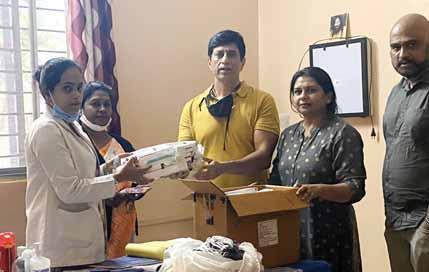
assistance will be given to nine food banks serving the hardest-hit areas in Detroit and its neighbouring communities.
A donation of $15,000 was made by global Rotarians to Gleaners Community Food Bank at a zoom meet on Dec 15. This amount was matched by Kroger, an American retailer, as part of their Double Your Donation Day activities. “With these funds, Gleaners can supply 90,000 meals to feed Detroit’s vulnerable families this winter,” says Mehta.
“We are happy to do this reverse global grant, for usually clubs in the US and Canada help people in India and other developing countries. Now Pune clubs have come together to contribute to this Detroit Project,” says Makarand Phadke, president, RC Pune Metro, RID 3131. This contribution by Indian clubs was appreciated by RI secretary general John Hewko, he adds.
requested his six AGs to contact their Rotary clubs for donating mortuary bags. Thirteen clubs in Salem have so far donated 806 mortuary bags and plastic rolls for about 500 deceased Covid patients at a cost of ` 3.5 lakh.
“District Covid chair Mohammed Elyas visits the GH every week to take stock of the body bags and make arrangements for its supply from Rotary, Inner Wheel clubs and other NGOs,” says R Mangeshwar, president, RC Salem South. The hospital dean Dr Balaji Nathan praised Rotary for its timely help in providing mortuary bags which prevent spread of the virus.

In a mega greening project, RID 2981 planted saplings over one million sqft to create Miyawaki forests in a span of 101 days, with 119 Rotary clubs in the district participating. “This project is our maiden experience in raising Miyawaki forests. The clubs left no stone unturned in approaching land owners, institutions, campuses and organisations in fulfilling their mission,” said DG R Balaji Babu. He recalled that the region, primarily an agricultural belt, was ravaged by hurricanes such as Gaja, Thane and the recent Nivar cyclone and “the environment suffered a great loss.” RC Thanjavur Big Temple planted saplings over 20,000 sqft at the Tamil University
campus; RC Tiruvarur made use of the 80,000 sqft provided by the Tamil Nadu Central University; RC Thanjavur Chola did their best in 20,000 sqft at Periyar Mani Ammai University; and even the cremation ground was not left out as RC Nagapattinam Midtown cleared the wild growth to create a mini forest over 60,000 sqft.
All the 15 clubs in Kumbakonam jointly created mini forests over 50,000 sqft. RC Kuthalam approached the Thiruvaduthurai mutt and got 10,000 sqft; RC Mayiladuthurai Pride made use of 1.08 lakh sqft and the two clubs in Karaikal covered 36,000 sqft with green shoots.
Explaining the process of creating the forest, Babu said the earth was dug for three feet, then natural manure was mixed with the soil and the pit was refilled. “The sapling was planted in tract, followed by the construction of spike fencing for protection. Drip water irrigation is arranged through borewells. An agreement is signed for 33 years to provide protection to the plants,” he said.
People are allowed to plant saplings in the backyard of their homes in villages if the planting is done in quarter acres as the 52 acres surrounding area is bound to benefit. This activity is bound to benefit future generations, “just the way we are enjoying the labour of our forefathers,” said Babu.
Jaishree
Savita is all set to start her own tailoring shop in Mysuru. “I underwent two courses — tailoring and as a beautician — for just `1,000. Elsewhere I would have had to shell out `15,000 for tailoring and `20,000 for doing a beautician’s course,” she says. Rashmi, another beneficiary, is now computer-savvy. “I can send mails, browse the internet and type letters,” she says.
Around 1,500 underprivileged women in Mysuru are now entrepreneurs running micro enterprises such as small tailoring houses, beauty parlours and computer
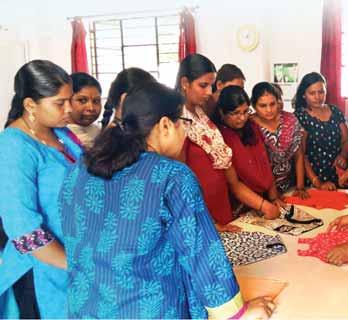

data processing centres; 500 more are gainfully employed in similar
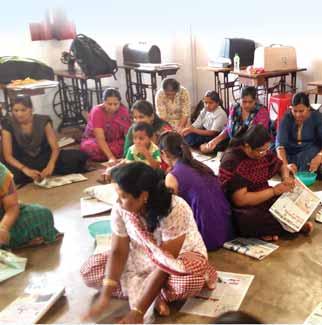
offices or do part-time jobs, thanks to a vocational training project
A paper bag-making class in progress.
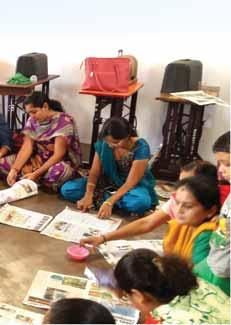
being run by RC Mysore West, RID 3181, for the past 17 years.
“We have a clear policy to empower women and create sustainable livelihoods and our projects are focused on building self-confidence in them,” says club secretary D K Dinesh Kumar. Many of these trained women have also formed self-help groups.
The club has set up the Paul Harris Vocational Training Institute in Dattagalli, a residential locality in Mysuru and imparts courses in tailoring, fashion designing, embroidery, beauty care, paper bag-making, basic
computer operations and spoken English. The duration of each course is six months. “Earlier we were offering free training, but the drop-out rate was heavy. People didn’t realise the value of these courses. So now we charge ` 1,000 a course,” he says. Each batch accommodates 30 women.
The club maintains a database of the students and helps in their placement or to avail loans from banks for setting up their own venture. The Rotarians also sponsor sewing machines for women from poor families. An orientation course in marketing is also given to women who plan to start their own enterprises.
The institute’s monthly expenditure is ` 2 lakh. “We get ` 60,000 as fees and the balance is met from generous contributions from our members and other philanthropists.”
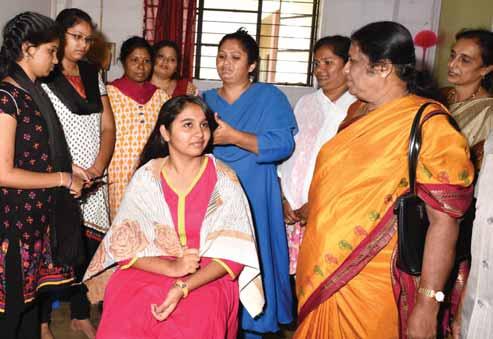
The event, where students are given certificates, is a gala one, where members of the Inner Wheel Club of Rotary West
organise rangoli, a fashion parade and cookery competitions and the trainees showcase their talent in various cultural programmes.
Anall-women’s club,
RC Sivakasi Diamonds, RID 3212, was chartered and installed by DG PNB Murugadoss in November. “We have implemented 11 service projects so far,” said charter secretary R Selvarani.
The new club donated a computer system worth `30,000 to the CSI Gnana Packiam Primary School, and this will benefit 36 students studying in Classes 1–5. A water purifier (RO) unit installed at the panchayat union elementary school, Kumarapuram, will provide safe drinking
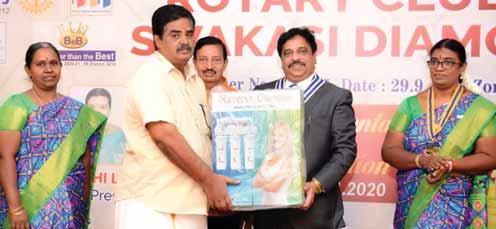
PNB Murugadoss gives an
Projects.
water to 60 students. Other projects include donation of 10 traffic batons to the local traffic police at a cost
of `6,000, a cash assistance of `3,000 to a needy student P Rithis, studying in Class 5 at the VSKD School,
Sivakasi, and honouring Rtn Velmurugan, a social activist, for donating blood for more than 40 times.
V Muthukumaran
As Rotary in India aims to make India fully literate by 2025, RC Bolpur Santiniketan, RID 3240, has opened two adult literacy centres in Sehalai and Bidyadharpur villages in Birbhum district of West Bengal. “We have set a target of making 100 adult illiterates, mostly women, literate in a year,” says Dr Biswadeb Chatterjee, club president.
Chatterjee has nurtured this dream of
opening literacy centres since he became president-elect and began touring villages for selecting the right places. The two chosen villages, Sehalai and Bidyadharpur, have almost an equal sex ratio and tribals constitute over 60 per cent of the population. “Around 90 per cent of the population in both the villages belong to SC/ ST category and are poor, illiterate, dependent on agricultural wages which are hard to come in most of the year,” he said.
Despite the lockdown and fear of the pandemic, he visited the villages falling under the Kasba gram panchayat to hold talks with the panchayat pradhan, gram sansad representatives and other leaders. “When we mooted the idea of a literacy centre, it was accepted with enthusiasm. The villagers were eager to learn to read and write and do some math just like their children,” he added.
While the centre in Sehalai is an open veranda
of a primary school, in Bidyadharpur the classes are held in an open space of a farm house and during rains, the centre will be shifted to a house.
New RCCs Rotary community corps were opened in the two villages in July so that volunteers can bring in women from homes and organise literacy classes for adults. To begin with, learners were provided with literacy kits including a slate and

An
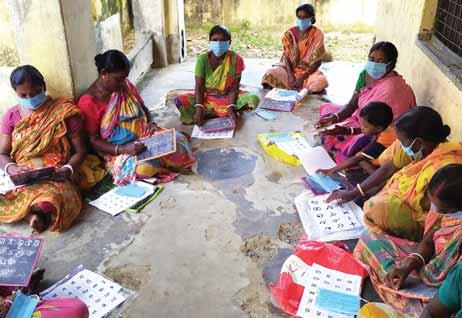
learning
chalks by the club. “Two undergraduate students from the respective RCCs were made instructors.
Gradually, Inner Wheel Club of Santiniketan and members of the All India Women’s Conference
Rotary for Ethical Treatment for Animals (RETA) was born after RC Allahabad Midtown, RID 3120, forged a partnership with PAWCO, an animal welfare organisation, for “mapping out a common vision to reduce the sufferings of pet animals” by rescuing and rehabilitating them in well-cared-for shelters. Club president Dr Divya Bartaria and
Project Chair Geetika Agrawal donated 150kg of grains, daliya (porridge), dog foods, blankets and other requirements in the project’s first phase. According to Dr Divya, “our next focus will be on animal birth control as PAWCO has already completed over 100 sterlisations in the district. This is the only humane way to check the population of stray dogs.” PAWCO is an animal charitable society
programme reached UNESCO, which referred to it on World Literacy Day on Sep 8.
The adult learners showed great progress in reading, writing Bengali alphabets, and doing basic math within the first three months of attending the centres. During his visit, DG Subhasis Chatterjee was pleasantly surprised to see an adult learner writing her name in neat, legible words.
(AIWC) took part in the programme,” he said. Through the AIWC-Delhi office, the club’s literacy
“I hope in a couple of months, the village women will be fully literate as per the norms of the RILM whose staff are invited to come and evaluate the neo-literates,” said Chatterjee.

RC Allahabad Midtown president Dr Divya Bartaria (extreme right) with club members donate dog feed to PAWCO, an animal welfare organisation.
formed by Advait Mohan and Samar Rahman during their chance meeting at a vaccination camp in 2017. So far the NGO has treated more than 500 sick
animals, got more than 20 desi dogs adopted, done 123 sterilisations, set up 30 permanent shelters and runs a round-the-clock helpline.
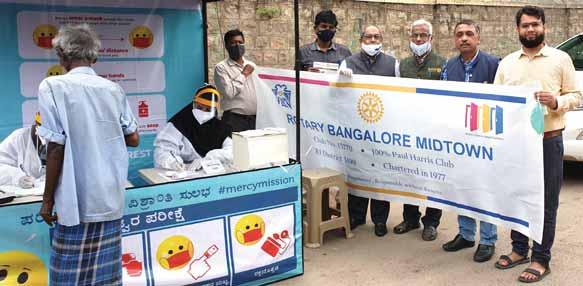
From L: Rtn Palani Loganathan, Rotary Bangalore Midtown president Ravi Nedungadi, S Jayaraman, director-Disease Prevention, DG B L Nagendra Prasad and Mohammad Ummer of Mercy Mission at one of the Mercy Booths.
As primary health centres and private hospitals in Karnataka are busy treating Covid patients, DG Nagendra Prasad, RID 3190, in consultations with S Jayaraman, district director, disease prevention, and Dr Sumukh, director, Project Positive Health, planned to screen 25,000 citizens for non-communicable diseases under the Know your numbers – Stop NCD project.
To begin with, it was decided to leverage the services of 40 Mercy Booths — fever clinics
being run by an NGO coalition for slum dwellers where temperature, oxygen saturation and BP are checked and the patients are sent to Covid testing, if needed.
Rotary Bangalore
Midtown led by its president Ravi Nedungadi became the lead club and soon 15 more clubs joined. Forty sets of screening kits comprising a glucometer, 500 strips, lancets, alcohol swabs, a digital BP meter, digital weighing scale, a stature meter to measure the height and 500 health cards with Rotary
logo were given to every Mercy Booth for checking patients. Each booth is manned by four health workers chosen from the community and trained to use these instruments.
The screening began on Nov 9 at these 40 booths and those above 40 years with comorbidities such as obesity, asthma, diabetes and hereditary conditions were given prominence. Many Rotarians also volunteer in the screening process. Dr Sumukh hosted a webinar to provide useful information on diabetes for Rotarians and public.
Pamphlets in English and Kannada on diabetes and hypertension are being distributed to people visiting the clinics.
“The Anns of Rotary Midtown collected funds to provide diabetes and BP medicines for 500 senior citizens for three months. Rotary Brigades president Ashwany Kinger has also arranged for free medicines to needy people at the fever clinics,” said Jayaraman.
Until Nov 15, 6,000 people have been screened. “Last year we had screened 5,000 people,” he said.












Can a single song capture the sheer magnificence of Hindi film music?
Listen to Man tarpat Hari darshan ko aaj from the 1952 film Baiju Bawra, scripted by Shakeel Badayuni, composed by Naushad, sung by Mohammad Rafi. A stunning symphony of voice, word and image, it is Bollywood’s best bhajan, put together by three Muslims!
Another Rafi masterpiece from the film is an international classic. Soaked in devotional ardour, Ae duniya ke rakhwale rises to a crescendo with the concluding word Rakhwale being repeated a few times, the voice soaring higher and higher!
Rafi’s career soared too, even before Baiju Bawra. He was the lord of the 1950s and 1960s. “He gave playback singing a new meaning,” says Javed Akthar.




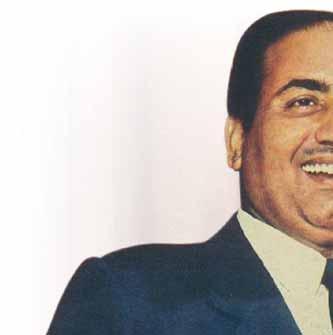

S R Madhu
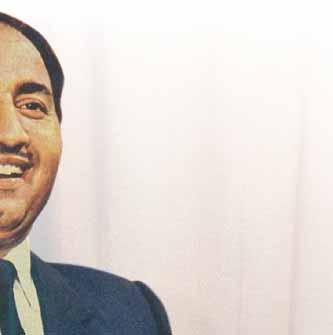

Naushad was asked in a radio interview during the 1990s: “If you were to compose the best music of your life now, what would you do? He replied: “I would pray to Allah to send back Rafi for an hour.” Manna Dey regarded Rafi as an institution by himself, a gharana
Why was Rafi the gold standard for Bollywood music?
The first reason is of course his voice — awesome in reach, expressiveness and malleability. “Rafi was peerless with voice modulation,” said music director Pyarelal. “He knew what to stress, how to stress, where to pause.”


Through his voice, Bollywood heroes appealed to their sweethearts in many moods — pleading, cajoling, wooing, fantasising, lauding, celebrating, agonising, sorrowing. But Rafi also erupted in flamboyance as a junglee, janwar, budtameez, loafer, bluffmaster.
Another reason for Rafi’s appeal is his ability to emote. He sounded like Dilip, Shammi Kapoor, Rishi Kapoor or Johnny Walker when he sang for them. He didn’t change his voice but his style, as SPB pointed out.
The Rafi journey
Mohammad Rafi (the exalted one) was born in Kotla Sultan Singh

with boxer Muhammad Ali.
village near Amritsar on Dec 2, 1924. Rafi’s father Hajji Ali was a cook — his culinary skills were much in demand at social and religious events. In 1926, Ali’s family of 10 moved to Lahore, where Hajji Ali set up a dhaba and Rafi’s brother Mohammad Deen set up a barber shop.
As a young boy, Rafi was drawn to the songs of a wandering fakir. He would sing the same songs later at his brother’s barber shop. His brother’s friend Hameed was so taken up with Rafi that promoting him became his own mission.
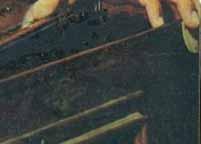




told Rafi and Hameed to see him in Bombay.
In 1944, Hameed and Rafi (then 20 years old) moved to Bombay. They took up a tiny flat in Bhendi Bazar, and spent their time knocking on the doors of music composers. Those were tough times. The two sometimes followed a rail track to their destination, since there was no money for a bus or train ticket. Roasted gram through the entire day was their only food.




When he was 13, Rafi sang at a function starring K L Saigal, when a power breakdown delayed the legend’s arrival. The boy sang without a mike, and the audience was astonished at the melody and voice control. Music composer Shyam Sundar was present; he
With Shyam Sundar’s help, Rafi and Hameed managed to meet Naushad’s father in Lucknow and get a one-line letter of recommendation to the famous composer. It said “Naushad, if you find this boy worthy, please give him a chance”. That one line became a passport to Bollywood. But the road to recognition was long and progress was slow.
















with former Prime Minister of India, Indira Gandhi.
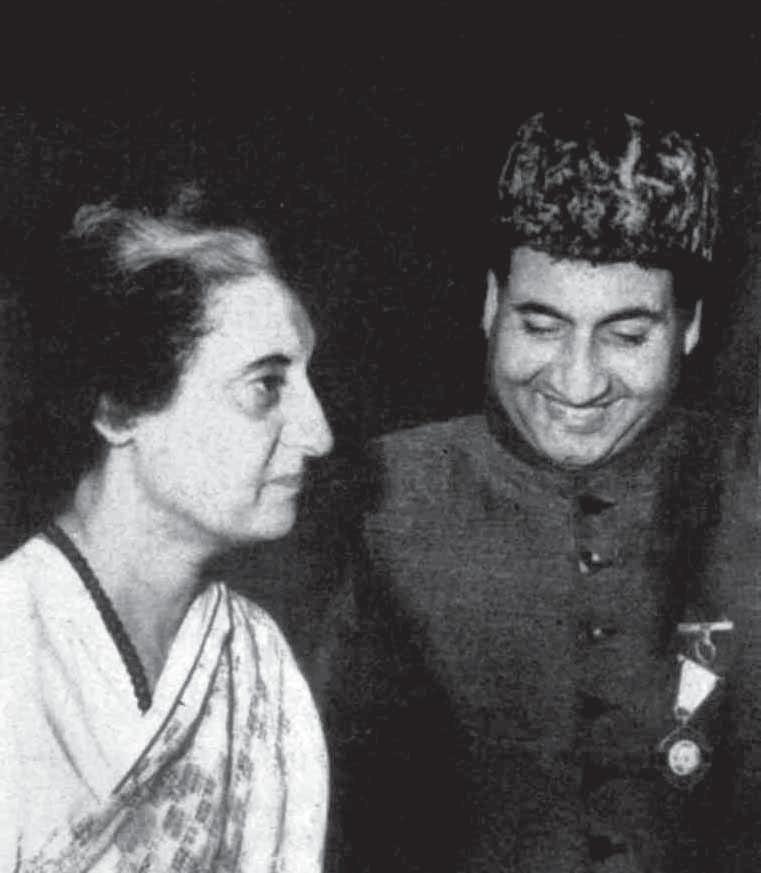
At one point, Rafi, who lived in Bandra in a crowded locality, had to go all the way to Marine Drive at 4.30am where he did his riyaz. Singer Suraiya heard him, was mesmerised by his voice, and offered him a room in her house to practice!
Rafi’s first super hit was the duet with Noor Jehan — Yahan badla wafaa ka (in Jugnu, 1947). In 1948, Gandhiji’s assassination led to the deathless song Suno suno yeh duniyawalo babu ki yeh amar kahani rendered by Rafi. (Lyric by Rajinder Krishan, music by Husnlal Bhagatram.) Pandit Nehru invited Rafi to sing the song at his residence. On Independence Day, 1948, the Prime Minister presented Rafi with a medal for his song. The following year, Suhani raat dhal chuki
(Dulari,1949), a haunting song of romantic yearning, captivated one and all.
Rafi’s fame skyrocketed during the 1950s and 1960s. Deedar (1951) was the first of several films in which Dilip Kumar’s charisma, Naushad’s genius and Rafi’s magic came together. Meri kahani bhoolanewale and Hue hum jinke liye barbaad from this film were masterpieces of heart-wrenching melody. With the 1952 Baiju Bawra, Rafi became the uncrowned melody king of Bollywood. He was a race horse that never slackened its pace. “Why don’t you fall ill sometimes so that others can get a chance,” Mukesh once told him light-heartedly.
One could write a whole book on how Rafi’s monumental
talent was behind the success of the top 100 Bollywood actors, lyricists and composers. Let me confine myself to just one actor.
Shammi Kapoor suffered 17 flops before scoring his first hit in Tumsa Nahin Dekha (1957) on the back of three Rafi songs. If Rafi’s high-voltage voice was mesmeric, Shammi’s energy and vitality were infectious. In Junglee, Shammi cast a spell on young India through Rafi’s magical voice, with two contrasting songs for Saira Banu — the high-pitched Chahe koyi mujhe junglee kahe, yahoo! and the sweetly imploring Ehsan tera hoga mujh par. Rafi sang 190 songs for Shammi Kapoor. Rafi sang 5,063 songs in his career, including 4,225 Hindi film songs. The honours he won included a Padma Shri in 1967, a national film award in 1977 as best singer, and six Filmfare awards. These were for the songs Chaudhvin ka chand, Teri pyaari pyaari soorat ko, Chahunga main tujhe saanj savere, Baharon phool barsao, Dil ke jharoke mein, Kya hua tera wada.
In 2001, Rafi was declared as “Best Singer of the Millennium” by Hero Honda and Stardust magazine.
The sole setback in Rafi’s career was during the early 1970s, when he was displaced as Bollywood’s top singer by Kishore Kumar. The Rajesh Khanna phenomenon swept Bollywood, and led to most producers and composers making a beeline for his favourite, Kishore. Rafi recovered his nous during the latter half of the decade, but he was felled by a heart attack in 1980.
Here are just a few of my Rafi favourites.
Romantic songs:
• Chaudhvin ka chand ho (1960, Chaudhvin Ka Chand. Composer: Ravi)
• Abhi na jao chod kar (1962, Hum Dono, Jaidev)
• Mere Mehboob tujhe (1963, Mere Mehboob, Naushad)
Reflective songs
• Jinhe naaz hai hind par woh kahan hai (1957, S D Burman, Pyaasa)
• Main zindagi ka saath nibhata chala gaya (1961, Hum Dono, Jaidev)
• Man re tu kahe na dheer dharey — (1962, Chitraleka, Roshan)
Sad songs:
• Toote hue khwabon ne (1958, Madhumati, Salil Chowdhry)
• Dekhi zamane ki yari (1959, Kagaz Ke Phool, S D Burman)
• Din dhal jaaye (1965, Guide, S D Burman)
Some Rafi anecdotes
• Rafi loved O P Nayyar’s racy, catchy, peppy tunes, which he rendered with gusto. Rafi would sometimes hum Yun to humne lakh sangeetkar dekhe hain, OP Nayyar sa nahin dekha. But in 1966, a rift broke between the two. Rafi came late for a recording of Sawan Ki Ghata, delayed by the recording for a ShankarJaikishen movie. The reason rather than the delay angered Nayyar. He cancelled the recording, and said he didn’t need Rafi any more. They didn’t work together for three years, but Rafi called on
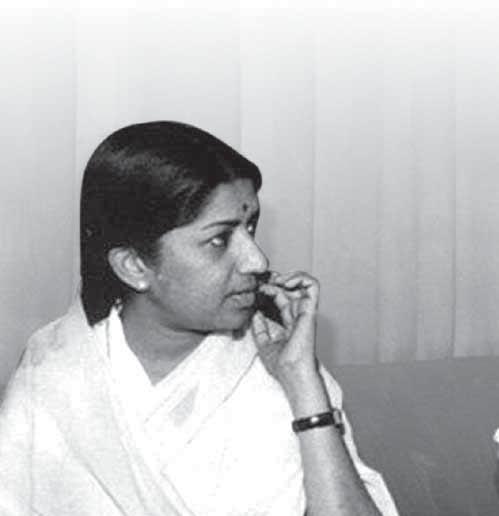
Nayyar one day and the two made up.
• SD Burman and Rafi made magic in numerous films. It was an SD Burman Nite that reunited Lata and Rafi in 1967 at the Shanmukhananda Hall in Bombay, after the two legends had stayed apart for four years. Nargis and Madan Mohan were the two emcees at a live music show. They announced a “great surprise”. Lata and Rafi entered the stage from opposite sides, to thunderous applause.
• Composer Omi (from the Sonik-Omi pair) recorded a qawwali with Rafi and Asha for the film Dharma in 1973. Omi wanted the song re-recorded, and Rafi was upset. But Rafi visited Omi next morning with a pair of huge US-made speakers and asked Omi to listen on the speakers to the
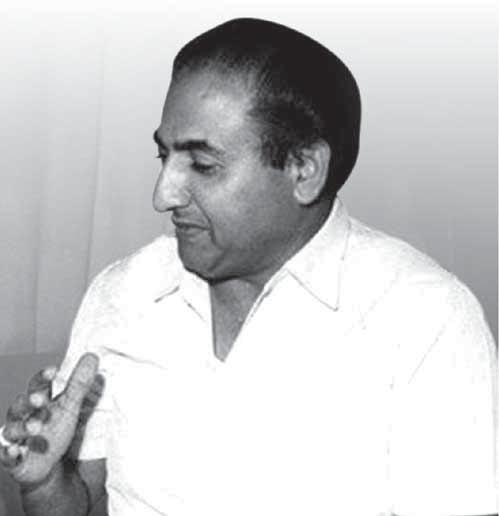
























qawwali recorded the previous night. Result: no re-recording.
“These speakers are for you,” Rafi said. His fee for the song was `3,000 and he was gifting Omi speakers worth `20,000!
“That’s Rafi for you,” said Omi.
Live shows — in India and abroad
Rafi was a teetotaler; his intoxication was mass adulation! His live shows began in 1960, with a tour of East Africa.
He accepted with alacrity a request to entertain jawans of India’s Border Security Force in 1962 at the India-China border.
Dilip Kumar was a partner in this event. Dilip says that the day before the show, Rafi lost his voice because of a severe cold and a throat infection. Dilip Kumar kept giving Rafi his own concoction of a ginger and honey drink. And it worked! On the morning of the show, Rafi found that his throat had cleared. The show was a rousing success. A 1977 anecdote. Shashi Kapoor had just re-started
with former Prime Minister of India, Jawaharlal Nehru.


Prithvi Theaters. He organised two music shows on successive evenings in Siliguri, West Bengal, to honour the memory of his father Prithviraj Kapoor. Rafi sang on the first evening, to a tumultuous reception. Amitabh
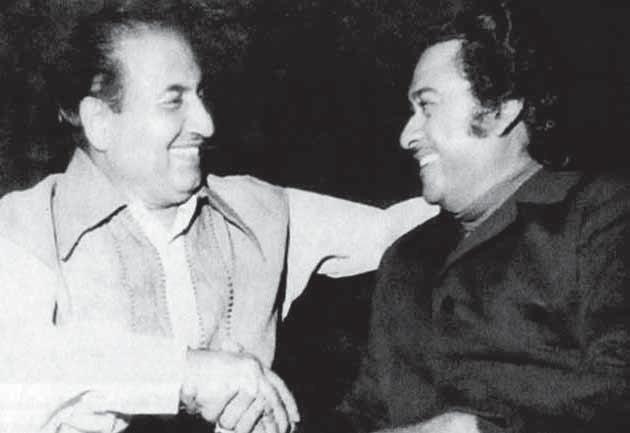
Bachhan, Rekha, Randhir Kapoor and Shabana Azmi also took part.
The second evening’s show was to be performed by Sulakshana Pandit and her team. Rafi left that morning for the airport, but the organisers were hit by a bombshell. Sulakshana would be unable to come. There was panic, because all tickets had been sold. Amitabh rushed to the airport, and persuaded the astonished Rafi, already in the aircraft, to exit. He did a second show, the audience was delighted. They couldn’t have enough of Rafi.
Personal life
Rafi had seven children — four sons and three daughters. Shahid, the only surviving son, runs a garment business in Mumbai and stays at Rafi Villa. One room in the house is
a Rafi museum, containing Rafi books, photographs and other memorabilia.
Rafi didn’t want his children to take up singing or even be a part of the film industry. He preferred that they do business. He sent all his four sons to London. He was austere and reserved in his personal habits — he avoided liquor and cigarettes and rarely socialised. His one pronounced weakness was food. He was fond of sweets, and wife Bilquiz had to restrain him because he was a diabetic. He usually took to work a few flasks of special tea made by Bilquiz — milk boiled with a mixture of almonds, cloves and cardamom.
His hobbies were carrom, badminton and kite-flying.
A fan of boxer Mohammad Ali, Rafi wanted to meet the famous pugilist when he was in Kentucky in 1979 during a multi-city concert tour. The great boxer heard that a famous singer from India was very keen to meet him. Ali responded and visited Rafi at his hotel. At Ali’s suggestion, photographs were taken of the singer and the boxer punching one another. Rafi was fond of attractive watches and stylish cars. A blue Audi that he had bought in London was his favourite car. His generosity was legendary. A friend recounts that when a beggar asked him for money, Rafi gave him all the money he had. “Don’t you count the money before you give it,” asked the friend. “When God doesn’t count what he showers on me, why should I count what I give others,” he remarked.
On July 30, 1980, Rafi suffered a massive heart attack,
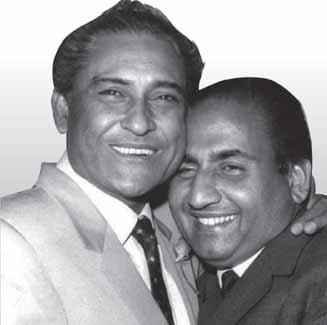
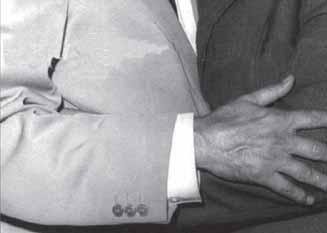

and passed away at 10.25pm The burial was organised in pouring rain. Thousands of fans flooded the streets to take part in the funeral procession from Bandra to the Santa Cruz kabristan, while flowers were showered from balconies.
A shrine for Rafi stands in Birmingham, England. A fan in Ahmedabad has built a temple-cum-museum for him in his own house. But “Rafi is enshrined in the hearts of millions of his fans,” says Javed Akhtar.
Editor’s pick
• Chaudhvin ka chhand ho
• Abhi na jaon chhod kar
• Mein zindagi ka saath nibhata chala gaya
• Baharo phool barsao
• Mere mehboob tujhe meri mohabbat ki kasam
• Khoya khoya chhand
The author is a senior journalist and a member of the Rotary Club of Madras South.
Designed by Krishnapratheesh S with Ashok Kumar.












V Muthukumaran
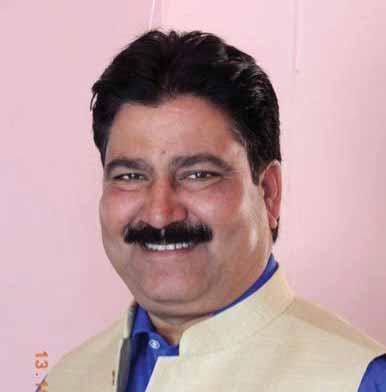
Harish Kumar Gaur HR consultancy,
With an extension of his tenure for the second year, Harish Gaur says, “due to Covid-related issues, I am keen to retain members and taking special efforts to induct the right Rotarians after an orientation so that they don’t quit the clubs.” He is hopeful of a 10 per cent growth in membership which stands at 2,800 across 64 clubs. The district will add one more all-women’s club in Rajasthan to the existing tally of seven and “we have set a 2–3 per cent growth in women members who constitute 16 per cent of our strength.”
Rotaract clubs are poised to touch 64 from 30 at the beginning of the year and “it is my wish the clubs sponsor at least one Rotaract club each in the district.” He is also working to increase the strength of Rotaractors to 1,500 by the year-end from around 900 at the start of the year. A mega water dam (GG: $70,000) inaugurated by Gaur at a village near Gwalior will enhance irrigation and fulfil other water needs of 25 hamlets. “We have planted over 1,000 saplings on its banks to retain groundwater. Fish rearing is also taken up at this dam,” he says.
Gaur will be doing 28 Happy Schools with CSR funding, mostly in Rajasthan, for which two GGs ($155,000) are under process of approval. Under a GG project ($62,000), OT equipment are being installed at the Government Hospital, Ajmer, and “we hope to complete the work by December-end.”
RC Bikaner has opened SDCL Daga Rotary Dialysis Centre with six machines at a project cost of $110,400 with a mix of GG ($20,000), DDF ($20,000), cash contributions ($42,000) and directed gift ($30,400). “We distributed 20 ventilators to government hospitals for a GG of $32,000 and the balance met through donations.” His target for TRF collection is $300,000. As a member of a cultural NGO, “I was drawn into Rotary by my friends and became a member of RC Bhiwadi in 2006.”
“We want to resume physical meetings”
Dinesh Chandra Shukla
Covid has induced an extended period of uncertainty in membership growth and community projects in RID 3110, says Dinesh Shukla.
“We are able to hold only online meetings and events, but members want two-way interactions and not just one-way communication and hence, interest in such webinars is beginning to wane,” he says. Secondly, the economic activity has taken a big hit in central UP and middle-class professionals, business and traders are looking forward to physical meets and one-to-one exchanges for exploring tie-ups and revive growth.
“But I am hopeful of inducting 300 new members, taking membership to 4,200 by June next year. And we are looking forward to resume physical meetings once the pandemic subsides.”
Women’s membership stood at 15 per cent in the district. “It is difficult to induct more women in clubs as most of them are housewives and are not
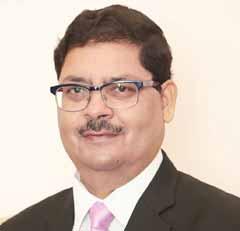
entrepreneurs.” As most of colleges and schools are closed, “we are aiming to add just 200–230 new Rotaractors and charter only a few Rotaract clubs in these Covid times.” Shukla will be inaugurating a dialysis centre with 10 machines at the Government Medical College Hospital, Kanpur (GG: `75 lakh approx).
He aims to collect $100,000 for TRF giving. “I will be taking up around 50 Happy Schools projects in Kanpur, Agra, Aligarh and Kashipur (Uttarakhand) through a mix of GG, DDF and private contributions. After becoming a chartered accountant, he joined RC Kanpur Gangaghat in 1987 due to peer pressure from “my friends who asked me to join social clubs to develop acquaintances.” Very soon, he shifted to RC Kanpur West.
Motwani
Membership retention is one of the focus areas, “that I am working on given the Covid challenges. But I am confident of adding at least 600 new members so that membership touches 4,000 by the end of Rotary year, thus netting a 20 per cent growth,” says Harish Motwani. At present, the district has around 3,400 Rotarians across 88 clubs. He is also keen to add at least 100 women members which will increase their strength from 10.8 to 13.8 per cent by June 2021.
Giving a big push to Rotaract is close to his heart as he will be opening 18 new clubs taking the district strength to 50 Rotaract clubs and “almost double the Rotaractors to around 1,600. I am also aiming to open 100 new Interact clubs, of which 18 were already chartered so far.” The district will be adopting 100 villages to make it blind-free through mega eye camps in which “free surgeries will be done with the help of Rotarian doctors and tying up with the local health officials.”
A dialysis centre (four machines) will be opened at the Mac Care Hospital in Ahmednagar (GG: $48,000).
“We are having two Covid care centres in Jalna and Ahmednagar, the latter is closed now as cases dropped. But Jalna centre is still active.” He targets $180,000 in TRF giving.
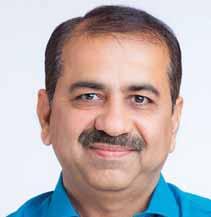
The district will hold a surgical camp either in Jammu or at a remote village near Ranchi after April.
“We are holding talks to send a medical mission to Zambia with 20 doctors and five volunteers by MayJune,” says Motwani. He was inspired by the PolioPlus campaign by local Rotarians which led him to join RC Beed Midtown in 1997–98. “My brother, a senior Rotarian, is my mentor and guides me in decision-making,” he says.
Aslew of Covid-related GG projects worth ` 4 crore including the setting up of five Covid care centres in Kolhapur are being implemented. “All the 14 clubs in this city have come together for this grand project at a total cost of $84,000. Each centre is replete with ICU beds and other equipment for Covid treatment,” says Sangram Patil. Swab testing equipment were donated to the Government Medical College Hospital, Miraj, in Sangli district of Maharashtra and Goa Medical College. In Belgaum, ten ventilators were given to the KLE Hospital and two dialysis centres were set up in Hubli hospitals. Patil is keen to implement at least 10 Happy Schools projects which will be done mostly in the Ichalkaranji town of Kolhapur.
Hope Express, a cancer detection bus, will be holding camps in remote areas for screening villagers for breast, cervical, oral and lung cancers. The project is being done jointly with the Kolhapur Cancer Centre.
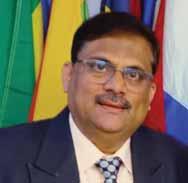
Patil is hopeful of adding 700 new members to take the membership to well past 6,000. “I will be adding seven new clubs to the existing tally of 133.” He will be chartering 30 new Rotaract clubs taking its strength to 95 by June next year, while Rotaractors are poised to increase from around 2,000 to at least 2,700. On TRF giving, the he hopes to collect $1 million. Patil will be graduating from Level-2 to Level-3 Major Donor. Having imbued his family value of selfless service, “I was inspired by my mother to join RC Gokul Shirgaon in 1993–94,” he adds.
Karunesh K Srivastava
Hospital service, RC Barabanki, RID
His primary aim is to retain members and try to induct 500 new Rotarians to take the district’s membership to 4,000 by June. “I plan to start 7–8 clubs and have already installed two all-women’s club and one more is in the offing,” says Karunesh K Srivastava. The district has 49 Rotaract clubs with 450 Rotaractors and this figure will touch 1,000 by June 2021.
Twenty-six Happy Schools (GG: $120,000, two CSR grants: $100,000) are being implemented in Gorakhpur. “We are setting up e-learning facilities, adult literacy centres and other RILM facilities. Handwash stations are being installed and toilet blocks renovated to make them gender-segregated units. A mega plastic-free campaign in Varanasi was launched to transport plastic waste to a recycling plant for generating electricity. His target for TRF is $150,000. Medical devices worth $100,000 raised through CSR funds were donated to the
Gorakhnath Trust Hospital, while cancer treatment equipment was procured under a GG worth $300,000. Cataract surgeries and another 10,000 eye surgeries are also being planned.
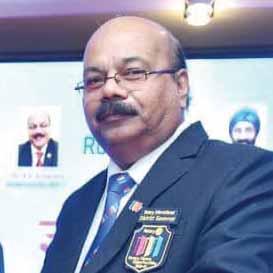
RC Renukoot is doing a GG project worth $100,000 for installing dialysis machines, while RC Mirzapur will be donating Covid equipment for ICU through a GG and providing equipment for cataract surgery. RC Gorakhpur will be donating Covid testing equipment (GG: $100,000) and RC Varanasi Sunrise is doing a GG project totalling $150,000 at the Mother and Child Hospital. Sewing machines are being provided to 20 vocational centres by 11 clubs. Srivatsava was inducted into RC Barabanki by PDG Alok Marwaha in 2006 as “I was impressed by Rotary’s activities to make the world a better place.”
Designed by N Krishnamurthy
The Board of Trustees in the June’20 Trustees Meet accepted the suggestion of WASH in Schools (WinS) steering committee and approved extension of the WinS Target Challenge pilot programme for a year, considering the unfavourable situation due to the Covid pandemic. While the pilot is now set to end in June 2021, all recognition applications must be submitted to TRF by February 20, 2021, to allow ample time for programme evaluation and presentation to Trustees before June 2021.
As many Rotary clubs are already working in WinS projects and may like to submit the star recognition applications, we request district leaders to encourage clubs/ Rotarians to submit their applications before Feb 20, 2021, to get recognised by TRF for their efforts.
Reach out to reeti.mondal@rotary.org at SAO for further clarification and information.
Online contribution — points to remember Debit card option: While making online contribution through www.Rotary.org or www.rotaryfoundationindia.org, members can also use either credit card or debit card to make payment by using the same link which says ‘Credit Card’.
Contribution from non-Rotarians: When an online contribution is made by a non-Rotarian from your club/ district, request them to share the online confirmation number along with club details with us at risao@rotary. org so that the contribution can be tagged to the respective club.
Public image in Covid times
Here are few tips to keep the engagement levels high digitally during these unprecedented times:
Take the time to train people on resources for remote learning and accessing RI’s online tools and resources
Make sure your club website is up-to-date, using the Rotary branding guides described in the Voice and Visual Identity Guidelines (available in the Brand Center by signing in to My Rotary).
Select one primary social media platform — such as Facebook, Twitter, Instagram or LinkedIn — and update it at least once a week.
Let the public know through virtual technology all the good work that your club is doing.
Try to get photos of your members actively performing service, either in their homes or out in the community. You can even livestream your service activities using tools like Facebook Live, YouTube Live or Periscope.
Record your livestreamed events and post them on your club’s social media channels and website.
Consistent communication with both members and the public is essential for keeping your club visible in your community. Capture screen grabs of virtual meetings and post it on digital channels to show that your club remains active. Post club bulletins and newsletters to update your members and community on your club’s activities, even if you aren’t meeting in person.
Most importantly, keep focusing on promoting service projects on social and digital channels.
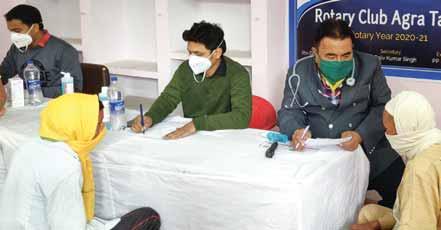
RCAgra Taj City, RID 3110, in association with Rainbow Hospital and Mayank Agency, organised a medical camp at Atus village, 15km from Agra. Over 300 villagers including women and children benefitted from it. Immunity boosting medicines were also given to them. Since most of the visitors wanted more information related to Covid, the doctors conducted an awareness session on the subject. Those in need of further medical investigation were referred to hospitals in Agra.


History is a spinning wheel, the future lies ever-present in the past.
hen Schindler’s List the film was released, in 1993, it created a sensation. What many don’t know is that the manner in which this true story was unearthed by a writer in Australia is even more sensational. Thomas Keneally then went on to publish the book, Schindler’s Ark , in 1992. I was reminded of Oskar Schindler by the book I am currently reading: The Last Train to London by Meg Waite Clayton, published in September 2019. To quote from the book’s blurb, it is: ‘…set in the pre-World War II era, based on the true story of the Kindertransport rescue of ten thousand children from Nazi-occupied Europe — and of one brave woman who helped them escape.’
This woman is Truus (Geertruida) Wijsmuller, a Dutchwoman, who dares to go into Germany over and over again, crossing its tightly secured borders to smuggle children out even as countries across Europe pull down their shutters, refusing to take in refugees desperate to escape the Nazi occupation. When the British government — alone among many countries — decides to open its doors to take in child refugees, Tante Truus — Aunty Truus — steadfastly
remains true to her efforts to save as many children as she can despite the huge dangers her mission involves.

Clayton’s story about this extraordinary woman and her even more extraordinary efforts is marvellously told. It’s not just an account of the rescue missions, amazing in themselves. Woven into its fabric is a parallel story, that of young Stephan Neumann, whose father is a chocolatier proudly carrying on the family tradition. His mother is sick, dying in fact, his little brother Walter’s best friend is a stuffed


toy called Peter Rabbit, and he himself is a budding playwright, admirer of Stefan Zweig, among the most famous Austrian writers of his time. His family is Jewish, cultured and rich, a fact he’s forced to come to terms with only when the Anschluss, the takeover of Austria by Hitler, becomes real. Apart from the danger his family is put into, Stephan experiences being ‘distanced’ from his best friend, Zofie-Helene, a mathematics genius whose mother is editor of an anti-Nazi newspaper. Be warned: it’s a slow read because the fine details take time and attention to comprehend, the nuances to absorb, and you begin to realise things you may not have in all your years of reading Jewish writers and writings about the Holocaust. Your heart is in your mouth when, on numerous occasions, Truus is called upon to negotiate tricky situations when crossing the border, or rather, borders, because there’s the border out of Germany and there’s the border into the Netherlands, where she lives and where she must first take the children. When she somehow manages to get visas for the children and the party of two adults and 30 children are ready to board the train, she finds a baby thrust into her arms. ‘Take her,’ the desperate mother tells Truus. When Nazi soldiers search her boot for contraband, live and otherwise, she must maintain a calm exterior while inside she is trembling like jelly because three children, little sisters, are hidden beneath her skirt and the floorboard of the car. On occasion she notices just how young these soldiers are, children themselves, almost innocent in their loyalty to the cause of the Third Reich. It is heartrending when Stephan discovers that Dieter, a friend who played so many roles in his plays, turns against him and dons the Nazi uniform without a second’s thought.




He then accompanies soldiers into the Neumann household to destroy it in a show of strength. Dieter feels guilty but his loyalty to Hitler overrides everything and even as he expresses concern for Stephan’s mother, he is desperate to catch Stephan who has disappeared. You see the tragedy, the injustice, the cruelty, the pathos, the exploitation. Everywhere you see dualities.
The idea of contradictions is brilliantly delineated in the style of writing and the language itself, and seems to bounce off the characters of Zofie and Stephan, so different from each other yet not apart. You not only find yourself drawn to the story, you stop every now and then to marvel at the images, especially the paradox of the real and the unreal, as in theatre, or the taste of chocolates, or watching a Jewish children’s home burning in the snow. Tante Truus saves countless children; she herself is childless, having miscarried many times. All this surfaces delicately, like froth that leaves traces on the lips after they have smacked on a much-relished milkshake.
How did the author chance upon this story? From her own child! Her son was a member of a theatre

group; its director had wanted his kids to write a play about the Kindertransport effort since few people seemed to know about it. She noticed how silent her son had become after he had interviewed some people who had been so transported. She writes how the ‘book was inspired by and is meant to honour Truus WijsmullerMeijer and the children she rescued, as well as the many people who made the Kindertransports possible. I have done my best to remain true in spirit to the facts of the Anschluss, Kristallnacht, and the shockingly rapid change in Vienna society in the few months between the two, including the role of the then-young and ambitious Adolf Eichmann, and the British and Truus’s efforts to bring about the first Kindertransport from Austria. But as this is fiction rather than a history, I have taken smaller liberties in the interest of story.’
It is true, though, that most of the rescued children never saw their parents again. The Guardian of November 6, 2018, has an article by Stephen Moss with a photograph of Jewish children arriving in London

in 1938. The article speaks of an exhibition opening at the Jewish Museum in London that featured the stories of six children who had come like this to the UK from Germany. ‘I visited each one of them [then in their 80s and 90s] in their homes and heard their remarkable, moving, often tragic testimonies,’ writes Moss. ‘Some never saw their parents again; all suffered the pain of separation; some were so traumatised they couldn’t speak of what had happened to them for decades afterwards — not even to their children. But in each the light of defiance, humour and commitment to life shines through. And each now goes into schools to talk to young people about what they and their parents suffered, testifying both as an act of remembrance towards their parents but also as a warning to the next generation that intolerance, hatred and scapegoating of minorities are ever-present threats.’

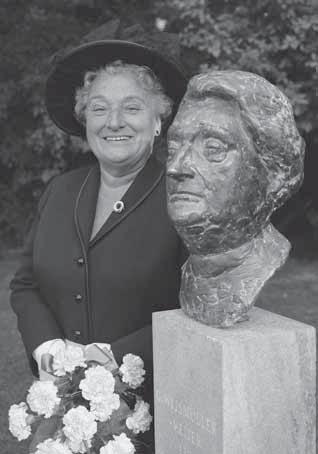
Truus Wijsmuller-Meijer in 1965.
We know this better than ever today: that intolerance, hatred and scapegoating of minorities are ever-present threats. That even as many cried ‘never again’ after the holocaust years, we see history repeating itself in Kosovo, Bosnia, Chechnya, Sudan, Sri Lanka, Kashmir, Nagaland, Syria, Columbia…. In practically every part of the world we see people turning against people simply because they can. History and records tell us that the mass extermination of Jews was the result of a carefully planned policy; orchestrated anti-Jewish violence was part of what was called ‘the Final Solution’. We know, too, that history is an ever-spinning wheel.
That’s why it is important to read books such as The Last Train To London — to read and remember the past, so that we can imagine a future for our children. So that children will never need to be separated from their parents again, even in the name of mercy.

Sheela Nambiar
Women need to pay more heed to their health and wellness.
Neglecting your own fitness and state of health leads to a poorer quality of life with unnecessary ramifications. Steady weight gain over the years is only one of the many problems.
How many times have we told ourselves that the weight we’ve gained with age is “normal”? How many times have we been told that suffering from chronic non-communicable disease (like diabetes, hypertension, depression, heart disease) is part of ageing and therefore needs to be endured and treated symptomatically with pills, potions and procedures? How many times have we been told and have believed that a chronic disease is ‘hereditary’ and inevitable because our parents had it?
All these diseases have been ‘normalised’ and accepted with great deal of resignation. I suspect this resignation also stems from the fact that we really don’t want to or don’t know
Muscles respond to external stress or ‘resistance’ as it is called, provided the stress is applied in the right direction and is of the right intensity.
to change the course of our health. Women tend to neglect their fitness/ wellness. There is always something else that seems to require their attention that is more important than their own health and wellbeing. Family, career, social work and so on. Sometimes this becomes an easy escape strategy to remain where they are, overweight or unhealthy with various degenerative illnesses. This is far from normal and should not be acceptable.
Speaking of fitness and weight alone (as there are other aspects of health I am not discussing here), as we
age, we gain 1lb of fat and lose ½ lb of muscle every year after 35 (earlier if you are completely sedentary). Extrapolate these numbers and you will have a vague idea of the “quality of content” (amount of fat verses the amount of muscle) of your body by the age of 60. Understanding what losing muscle and gaining fat can do to your body in terms of functionality, not just appearance, may help you sit up and pay attention. The function of muscles is locomotion or movement. Daily tasks cannot be performed if muscle mass and strength deteriorate. Accumulation of
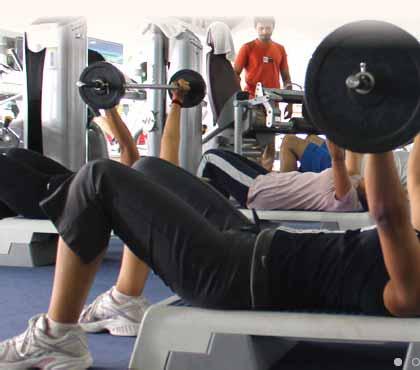
fat is not just about appearance. It hinders simple day-to-day tasks, acts as a repository of inflammation and toxins. The added weight places a great strain on the joints and spine, as they are not supported by strong muscles. It stresses the heart and lungs, which is why overweight individuals feel breathless while climbing stairs or performing any action which requires the heart and lungs to work harder. Unable to cope with excess weight and getting no help from the poorly conditioned muscles, the heart beats rapidly, sometimes even irregularly. The breathlessness is a result of the respiratory system trying to cope with the excess demand for oxygen by the working muscles. Poor oxygenation of the muscles leads to early fatigue and cramping as they try to work without oxygen.
This is not an irreparable situation. There is hope for restoration, in even the most extreme cases. The extraordinary
ability of the human body to rehabilitate is what makes it so special. The earlier one starts the process, the easier it will be and the better the results. But it is never too late to start a fitness programme. Studies have shown that even starting to train with weights to improve strength and introducing some amount of cardiovascular exercise even at 90 has beneficial spin-offs.
According to the WHO, we only require about 30 minutes of regular cardiovascular exercise (walking, running, cycling, aerobics etc) a day, five days a week for health improvement. They have also included strength training twice a week to build and strengthen muscle, which has been found to be a critical aspect of fitness.
Muscles respond to external stress or ‘resistance’ as it is called (as in weight training), provided the stress is applied in the right direction and is of the right intensity. This is important to emphasise as otherwise one might as well advise a 70-year-old woman to start training by shifting the furniture in her house. So it has to be personalised keeping in mind the age, fitness level, goals and health history of the individual.
Once you start exercising, you are in a better mood, able to deal with the mundane day-to-day activities or a stressful career without feeling overwhelmed.
enjoy the sensation of sheer power that accompanies physical strength. Simple acts of climbing stairs, squatting, rising from sitting on the floor, or even just sitting on the floor, become easier.
Thomas Alva Edison once said “If we all did the things we are capable of, we would astound ourselves.” This is true of our fitness levels too. As long as one is not afraid of failure and gets the right professional guidance, one can always look at progress in the three main aspects of fitness — stamina, strength and flexibility, at any age. Weight loss is a byproduct of regular exercise, not the sole benefit.
Ideally, all women need to train with weights to improve strength and increase muscle mass. This becomes even more important after 30 when muscle mass starts to deplete, and a woman’s bones have a tendency towards osteoporosis. Weight training prevents osteoporosis and the depletion of muscle.
When one discusses weight training for women, one is often met with mild horror, if not outright shock and indignation. The truth is, it need not be as frightening as it sounds. One can start slow, with lighter weights or own bodyweight exercises and then grow to challenge one’s muscles further by increasing weight. As one builds strength and confidence, one begins to
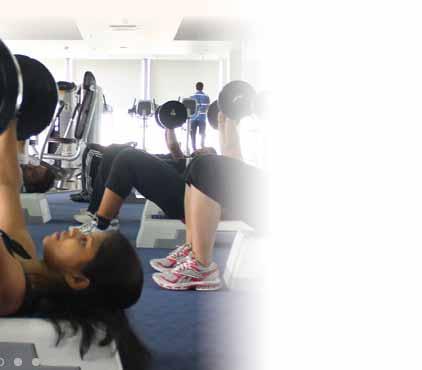
Take a stand, your health and wellness is important. Introducing fitness creates so much positive energy that it seeps into every other aspect of your life. Set aside at least an hour, even half an hour, a day exclusively for yourself. Start small and grow within yourself, improving your health, both physical and emotional. You will find that once you start exercising, you are in a better mood, able to deal with the mundane day-to-day activities or a stressful career without feeling overwhelmed or stressed more than necessary. It is all about quality of life, not just increased longevity.
The author is a lifestyle medicine physician. sheela.nambiar@gmail.com www.drsheelanambiar.com
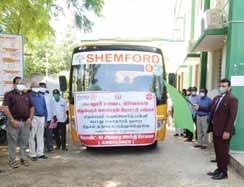
Four ambulances were handed over to the Cuddalore district collector Chandrasekhar Sakhamuri for ferrying Covid patients. The vehicles were arranged in partnership with the Shemford Futuristic School at a cost of `6 lakh.
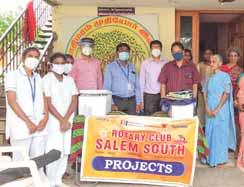
An NCD camp was held at Bodhi Maram, an old age home, in association with SKS Hospital. Around 75 people were screened for ailments and medicines were given.

To manage the crowds on Diwali eve, two watch towers were installed near the Gandhi statue in association with the local trade chamber following a request from police.
More than 300 pairs of shoes collected under the Xmas shoe donation drive will be recycled and made into slippers for the underprivileged people.
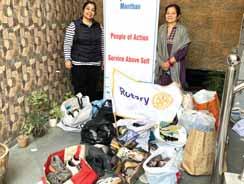
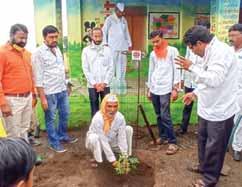
The club members planted saplings at a zilla parishad school in Visapur, and distributed tree guards for protecting the species.
Free cataract surgeries were done on patients who can’t afford the treatment.
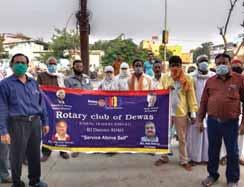
RC Alwar — RID 3053
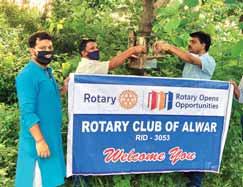
Bird feeders were placed at different parts of the city to provide food and water to birds as part of the club’s project Parinde.
RC Sriganganagar East — RID 3090
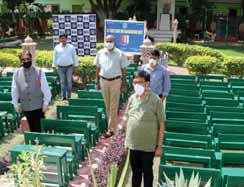
DG Vijay Arora handed over 75 benches worth `2.5 lakh to five government schools. The furniture was sponsored by PDG Sanjay Gupta in memory of his late parents. RC Vapi — RID 3060RC
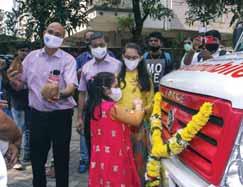
A blood donation van was flagged off by the club. The vehicle will visit remote areas to collect blood.
Around 500 face masks were distributed by club president Ashwani Saxena for the needy people as part of their Covid-relief projects.
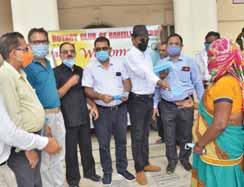
RC Jammu Trikuta — RID 3070RC Omerga — RID 3132

The Rotarians organised a painting competition for schoolchildren to create awareness on hygiene and sanitation.
A Covid food stall with homemade recipes was set up to help an underprivileged mother with a child to start her own enterprise.
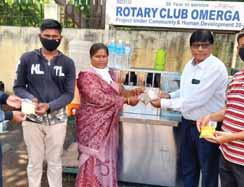
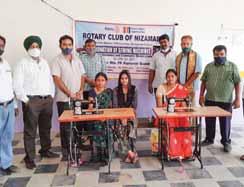
Sewing machines were donated to needy women to enable them to earn a decent income.
As part of the district project ‘Make roads safe’ PDG Abhinandhan Shetty inaugurated a hoarding erected on the NH-66 to create awareness among motorists.
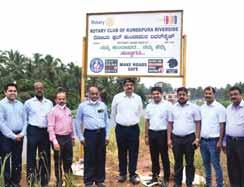

The club members donated woollen blankets and garments to 300 needy families of Dombari community living in rudimentary houses.
Coconut saplings were given to farmers under the Kalpavruksha scheme, a district project, to provide a sustainable livelihood to small farmers.
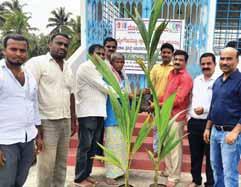
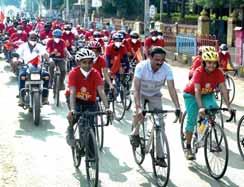
An End Polio cycle and bike rally was conducted in the presence of legislator Anand Nyamgouda. Around 25 participants took part in the rally.
Computer tablets worth `1 lakh were distributed to 15 children at Nochima village under project Vidya Dhaan.
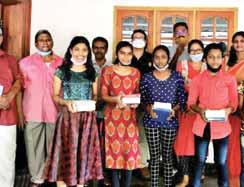

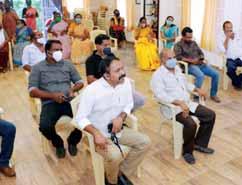
The club organised a diabetes detection camp at the Rotary Hall to mark World Diabetes Day.
An eye camp was held at Kakkum Karangal, an old age home, for the benefit of senior citizens as part of the club’s community health initiatives.
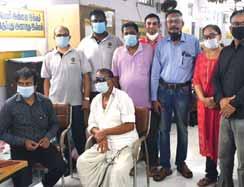
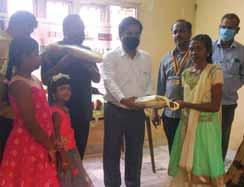
On the eve of Diwali, crackers, food and dress material worth `18,000 were sponsored by Rtn Senthil Kumar for the inmates at Udhavum Ullangal Vallalar Illam, an orphanage at Palayamkottai.
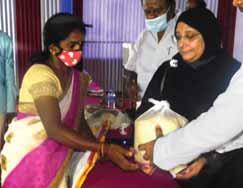
Rice bags were distributed to 50 beneficiaries by state minister for labour and wakfs Neelofer Kafeel in the presence of PDG K Jawarilal Jain.
A three-wheeler with Covid dos and don’ts poster and audio message was flagged off to create awareness on the pandemic in remote areas, slums and residential colonies.
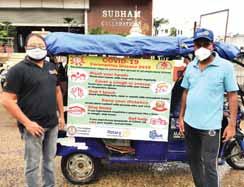
A polio immunisation campaign was conducted at a corporation ward with speakers fitted on an auto to spread the message of vaccination.

Compiled by V Muthukumaran
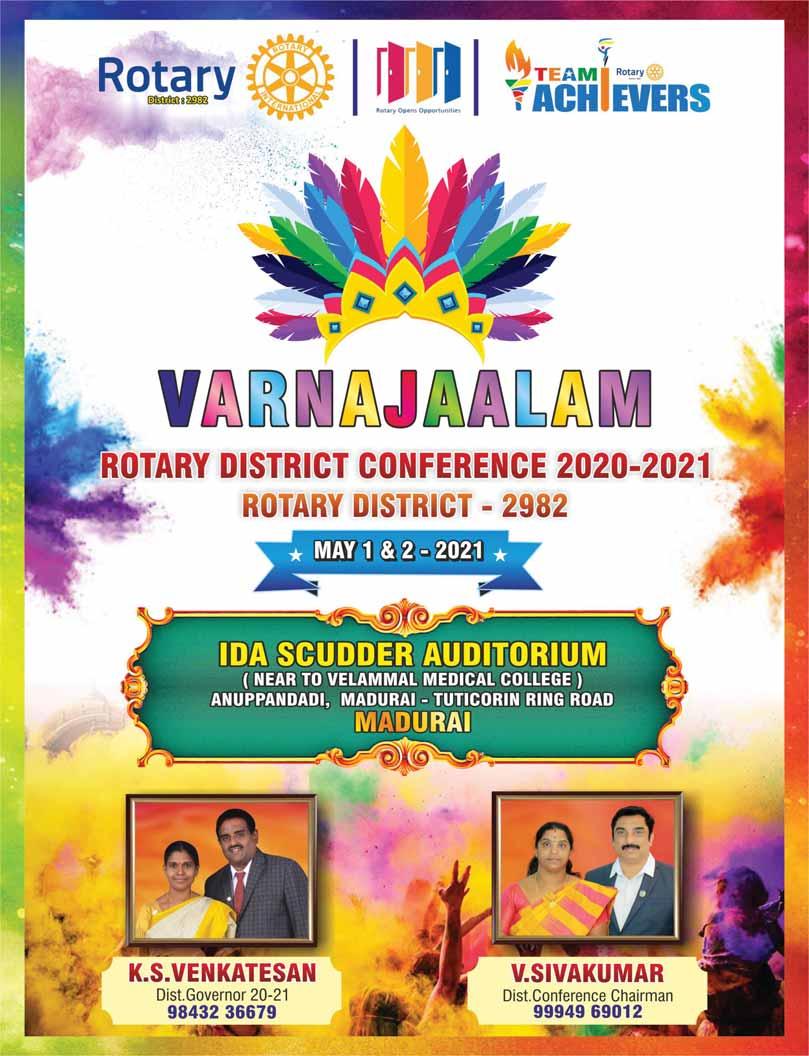
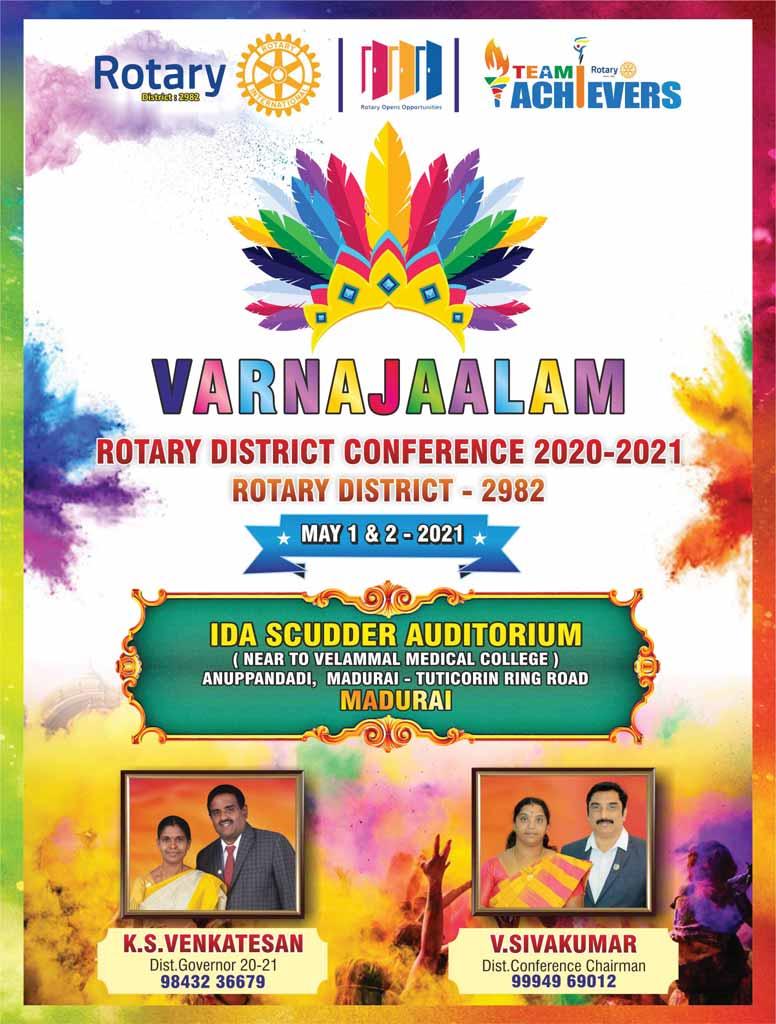
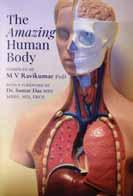
Author : M V Ravikumar
Publisher : Kaveri Trust
Pages : 76; `99
Acompilation of interesting facts about the various organs and systems of the human body. Written in simple English, the book talks about things that go on in our bodies, that we have no idea about as we go on about our day. Be it your new found high in the morning or how many times your heart beats a day. It’s easy to forget how amazing the internal organs, eyes, or even the basic building blocks of life are. This book works as a gentle reminder on how fascinating each part of our body can be.

Author : Soumya Mohanty
Publisher : Notion Press
Pages : 278; `320
Rupa, a simple, beautiful girl in love with the author, is diagnosed with stage-four cancer. Everything comes to a standstill for the couple as they begin to fight the cancer. Written in an autobiographical mode, the book talks about love, life and what it takes to move on. The author talks about the struggle of a couple while dealing with an exhausting routine and doing everything it takes to save the love of your life. We follow the couple through their visits to the doctors, to temples and the partner waiting outside the ICU with hope and despair at the same time.
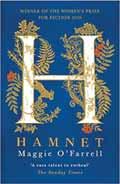
Author : Maggie O’Farrell
Publisher : Tinder Press Pages : 372; `999
Hamnet is an imaginative take on Shakespeare’s love life ,Agnes, the early days of their marriage, and the death of one of his children due to the bubonic plague. This is the story of Agnes and the emotional and psychological challenges of bereavement she faces. The book takes us back and forth from 1580 to 1599, the time where Shakespeare wrote his play Hamlet. At its heart, this is a story about grief and how a mother finds her way around it. Interestingly not once does the author call the playwright by his name in this book. The story includes magical beliefs, myths and superstitions of the time.

Author : Susanna Clarke
Publisher : Bloomsbury
Pages : 245; `570
Piranesi is alone and has no great memories, but curiously is content inside his big house, which has endless halls and countless rooms. The house and the world are one and the same for him. While birds have built an entire town for themselves in the house’s upper halls, stormy tides flow through its lower levels. He wanders the empty halls and courtyards, documenting everything in his journal with satisfaction. He sustains himself with catching fish for food and burning dried seaweed during the winters. There is one other person — a man called The Other who visits Piranesi and needs his help to unravel a secret knowledge, revealing terrifying truths and a world beyond the labyrinth house.
Compiled by Kiran Zehra
Like everyone else I have also acquired friends over the years but retained only a few, 27 in all if you want to know. These retained friends fall into five broad categories: economists, journalists, accountants, bureaucrats and historians. Strangely, I don’t have any engineers and doctors as friends. I do know a few but it would be a stretch to call them friends. As might be expected, the vast majority of my friends are men but there are five women too. They stand out because they view things so differently. For example, for men their ego comes first but for the women it comes last. They prefer common sense, instead. But gender differences aside, it’s very interesting to see how their professional training determines how these friends — men and women — view and approach things.
The economists look at everything from the point of view of efficiency. They keep asking if there is a better way of doing things. The journalists look at everything as a potential story. This means they usually look bored. The accountants keep asking for more data. This can be irritating because often they refuse to enter into a discussion. The historians take the view that there is nothing new at all in the world except technology. Depending on the topic they start with the Rig Ved. But it’s the bureaucrats who
infuriate everyone else because they disagree as a matter of principle. You can’t argue a point with them on the basis of history, economics, science, technology or data. They are also quick to get offended. And according to them, as a journalist, I am just a nuisance.
For the last seven months the discussion has been mostly about the Corona virus. It has been fascinating to observe the different ways in which the problem has been perceived. The historians talk about all the pandemics since the beginning of time and say it is all a matter of chance. The economists discuss the costs of research, production, pricing and delivery. The accountants simply look on glumly because there is no data at all to go by. The journalists peddle unverified and unverifiable rumours and the bureaucrats keep saying how the rules don’t permit this or that.
For the first few weeks everyone talked about how many people

would die in India. Then, when the death rate began to fall, the talk was about how many would get infected. Then as news of vaccine development picked up, the discussion was over whether it would be available this year or next. And now it is about how long we will have to wait. In all this, it is the journalists who have been the most annoying, followed by the bureaucrats, because neither lot has anything useful to say. The historians have regaled everyone with the history of vaccines and the economists with their views on work-from-home. The accountants have just looked on silently wondering, no doubt, how they could have become friends with such stupid people.
For men their ego comes first but for the women it comes last. They prefer common sense, instead.
My problem has been that I am a bit of everything and I usually agree with everything everyone says. So the others think I am very wise. The truth is I don’t care to hold a strong view. Also, how badly someone gets infected is a matter of luck. For example, three close relatives got infected. Two were over 90 and are fine. One was just 60 and is dead. I think that since it is a virus, sooner or later it will infect everyone who isn’t careful — mask, sanitiser and avoiding crowds. This is common sense and has made me extra popular with the women. As I approach my 70th year, that’s not a bad reward for not holding strong views.

Salwa Hussein (39), a mother of two, has undergone a life-saving surgery so radical that she now carries her heart in a backpack. Inside her nearly 7kg backpack are batteries, an electric motor and a pump that pushes air through tubes to power plastic chambers in her chest which push blood around her body. A caregiver has to be beside her 24/7 just in case the batteries run out and they have 90 seconds to connect her to the back-up machine.

Photos of a white house have gone viral after they were posted on Instagram. The photograph shows a picturesque log cabin perched on a green hillside, surrounded by blue seas. The tiny white house, standing all alone on a remote island, has given rise to mysterious theories. This isolated house is also referred to as an introvert’s dream home.

According to a Livescience report, scientists in the Netherlands have accidentally discovered a new organ in the human body while carrying out research on prostate cancer. The set of salivary glands set deep in the upper part of the throat have been named tubarial salivary glands. Researchers at the Netherlands Cancer Institute confirmed the presence of the glands after examining at least 100 patients. The discovery is said to be important for cancer treatment as doctors using radiation on the head and neck to treat cancer try to avoid irradiating the salivary glands because damage to these glands can impact the quality of life.
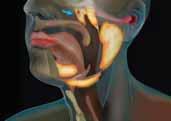

What do you do if your child’s favourite doll lost a leg? If you’re in Japan, you can now bring it to a toy clinic. This clinic in Tokyo specialises in restoring stuffed toys to their original glory. The toys are repaired in about 10 days at prices ranging from 10,000 to 500,000 yen (`7,000 – `3.56 lakh). The clinic’s website features photographs of recovered toy patients waiting for discharge.
You could bag a chance to win a stay at Gauri and Shah Rukh Khan’s Delhi home. All you have to do is fill an application on Airbnb and explain in less than 100 words, what a perfect “open arm welcome” means to you, in line with the actor’s signature open arms pose. The home has been designed by Gauri and reflects the Khans’ journey as a couple, and as a family, brimming with personal keepsakes and collectibles from their travels around the world. Guests will be treated to a festive dinner of the Khans’ favourite foods and movie marathon of Shah Rukh’s notable films and a personalised gift from the family as a treasured memory.
Regn. No. TN/CCN/360/2021-2023
Licensed to post WPP No.TN/PMG(CCR)/WPP 431/21-23
Total number of pages in this monthly issue, including cover, 84. Price: `35
Registered with Registrar of News Papers for India 3880/57 Rotary News Published on the first week of every month






